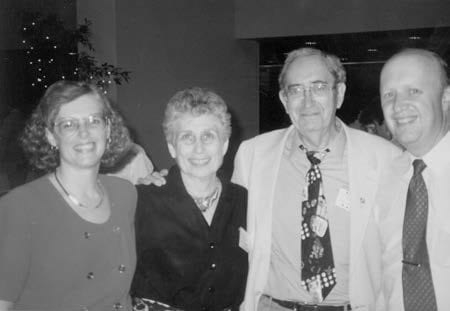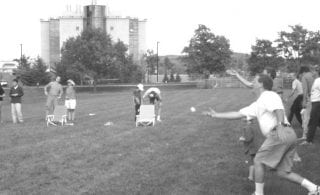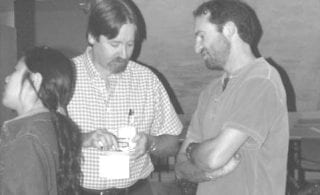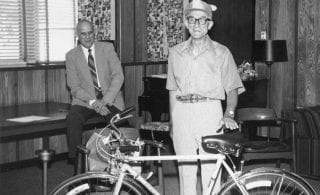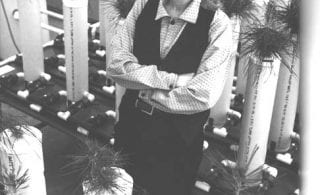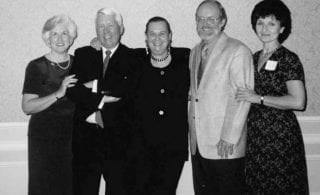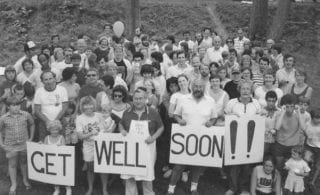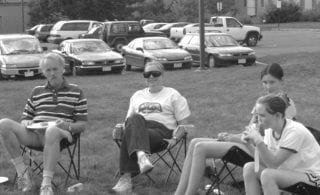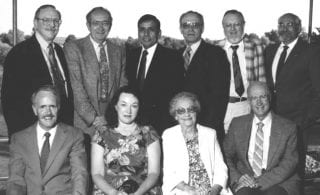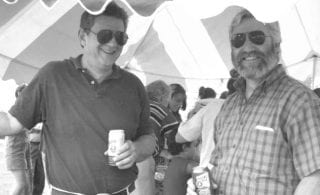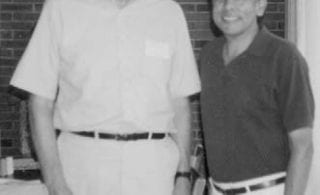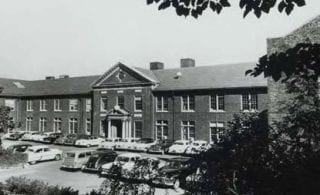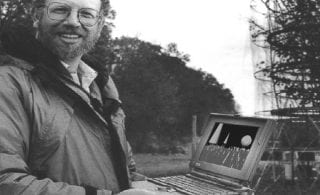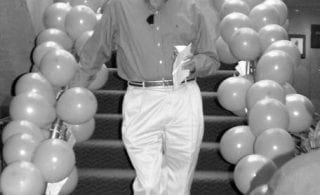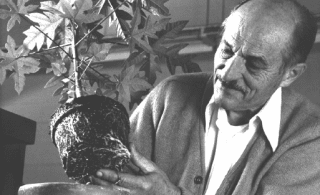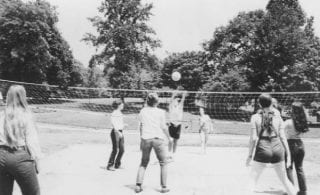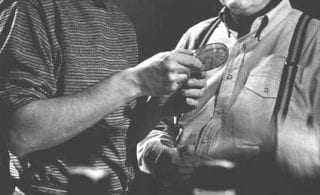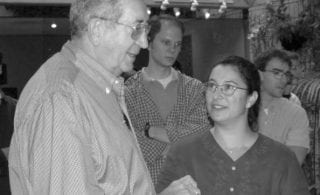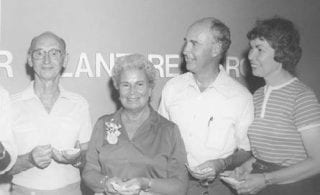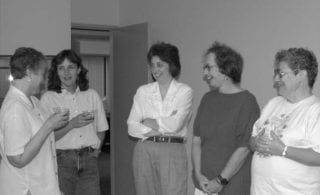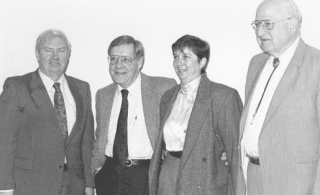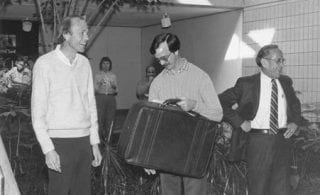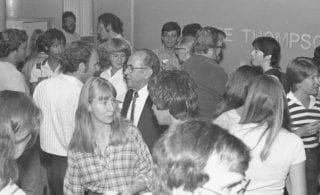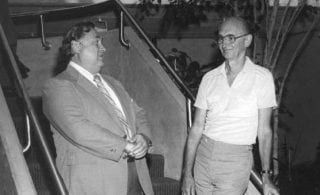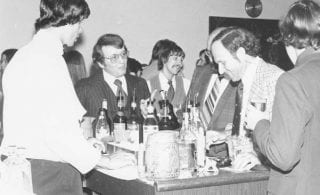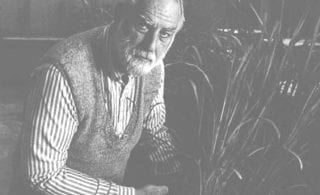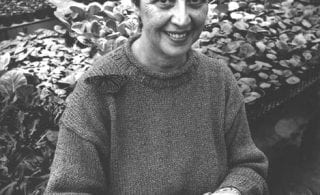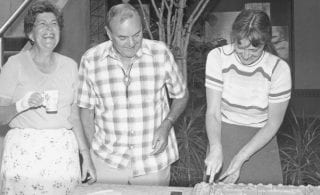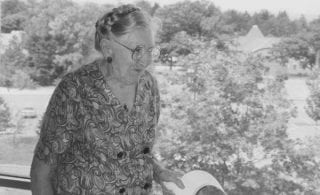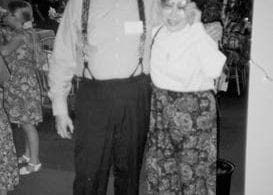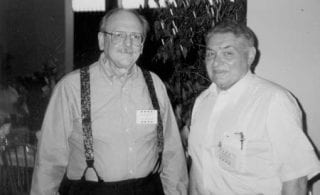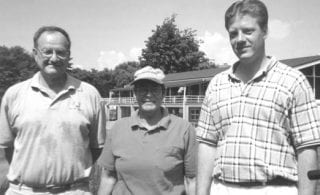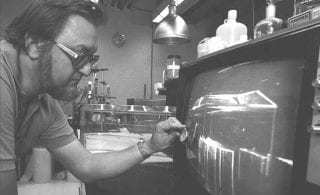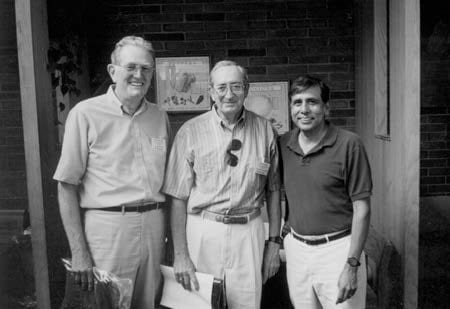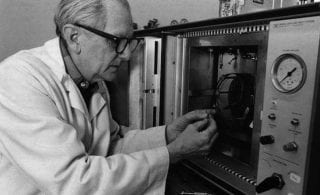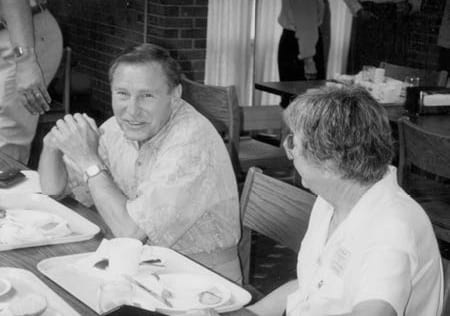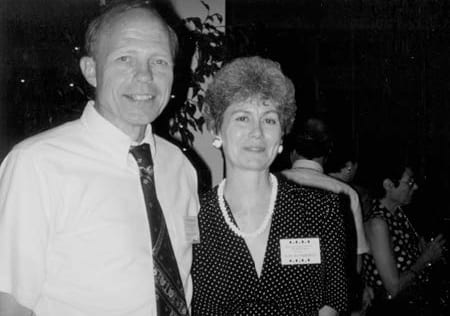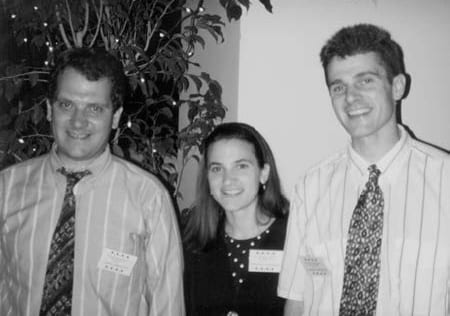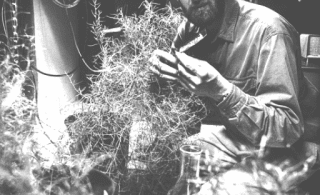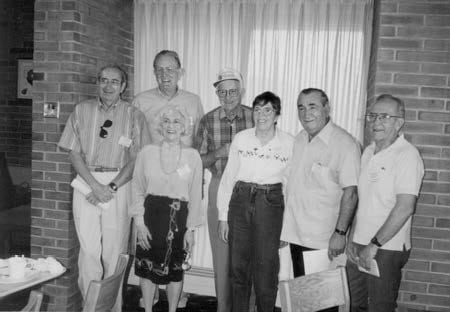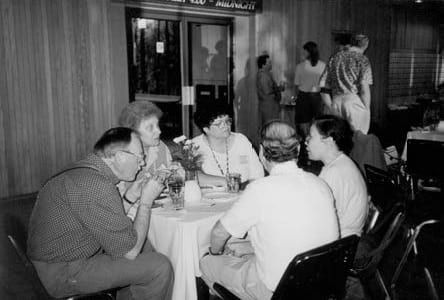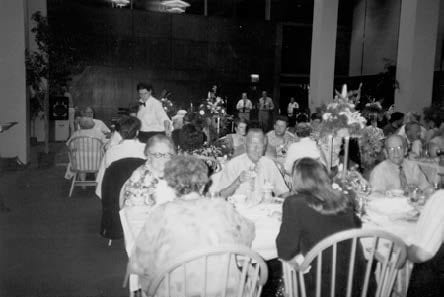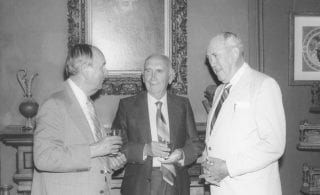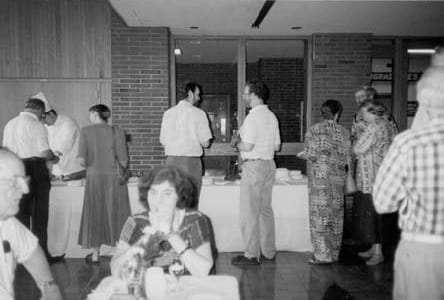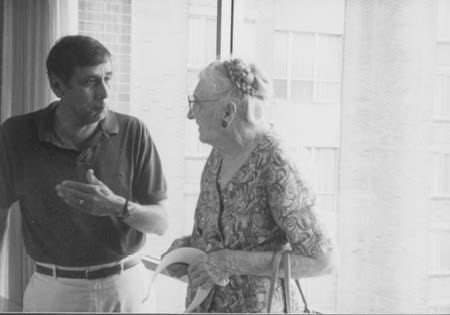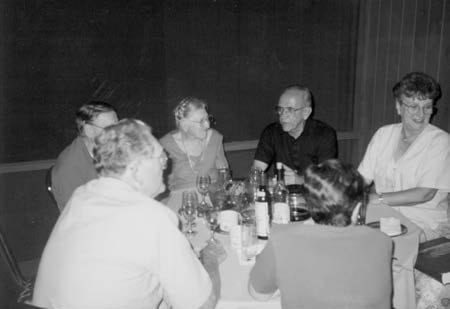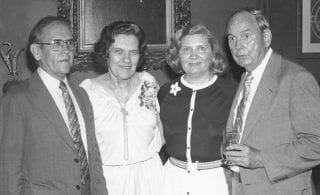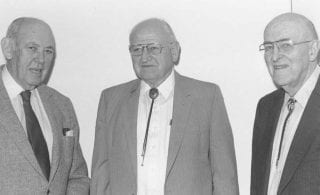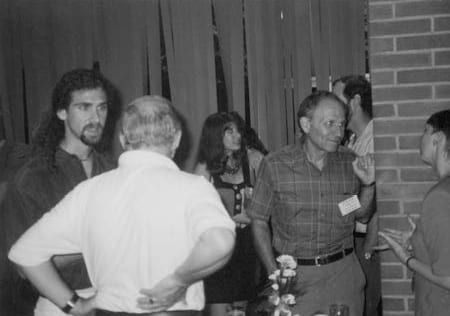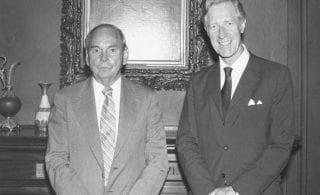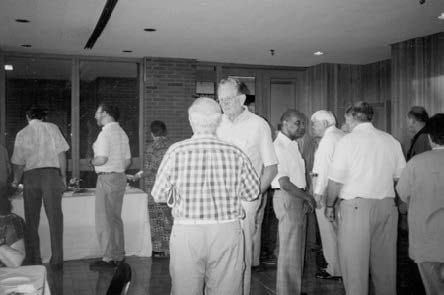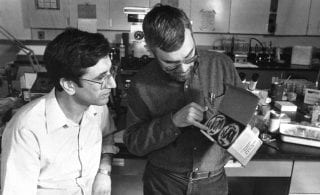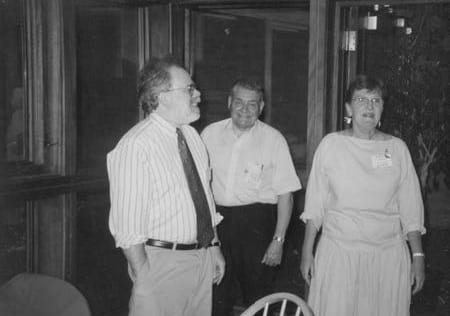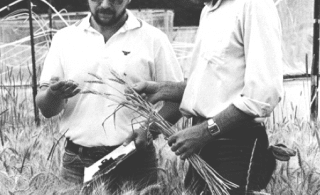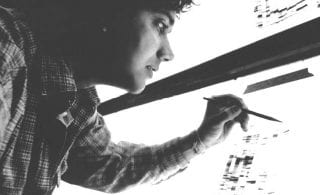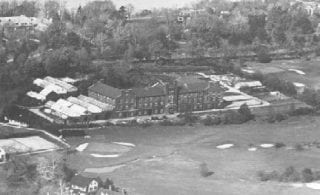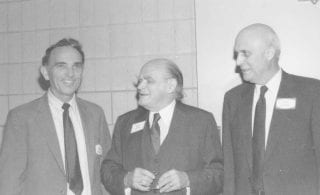History
The Colonel
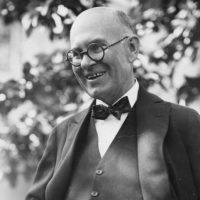 William Boyce Thompson (1869–1930) was a rare combination of hardheaded realist and dreamer. He was schooled in the rough mining towns of Montana and at Phillips Exeter Academy mining stocks on Wall Street and owning and operating mines. He was not only a shrewd man of business but also had great intellectual curiosity, particularly about science. He wished to be a force for good in the world and supported various philanthropies. Thompson’s life is chronicled in his 1935 biography The Magnate. He visited Russia in 1917, just after the overthrow of the monarchy, when civil war was raging and starvation was rampant. Thompson was a member of an American Red Cross relief mission that was present during the political unrest after the abdication of the czar, the interim government of Kerensky, and rise of Lenin and Trotsky. He was awarded the honorary title of colonel by the American Red Cross. The mission saw firsthand the suffering of the people and the inability of the social democratic government headed by Alexander Kerensky to feed the hungry. Although Thompson added more than $1 million of his own to the relief funds provided by the U.S. government, he was unable to convince President Woodrow Wilson to do more. Soon after the Americans had returned home, the Kerensky government fell and the Bolsheviks came to power. Thompson’s hopes for a prosperous democracy in Russia were ended. The Russian experience convinced him that agriculture, food supply, and social justice are linked. World political stability in the future, he prophesied, would depend on the availability of adequate food. This conviction, along with his faith in science, helped to shape his next philanthropic project.
William Boyce Thompson (1869–1930) was a rare combination of hardheaded realist and dreamer. He was schooled in the rough mining towns of Montana and at Phillips Exeter Academy mining stocks on Wall Street and owning and operating mines. He was not only a shrewd man of business but also had great intellectual curiosity, particularly about science. He wished to be a force for good in the world and supported various philanthropies. Thompson’s life is chronicled in his 1935 biography The Magnate. He visited Russia in 1917, just after the overthrow of the monarchy, when civil war was raging and starvation was rampant. Thompson was a member of an American Red Cross relief mission that was present during the political unrest after the abdication of the czar, the interim government of Kerensky, and rise of Lenin and Trotsky. He was awarded the honorary title of colonel by the American Red Cross. The mission saw firsthand the suffering of the people and the inability of the social democratic government headed by Alexander Kerensky to feed the hungry. Although Thompson added more than $1 million of his own to the relief funds provided by the U.S. government, he was unable to convince President Woodrow Wilson to do more. Soon after the Americans had returned home, the Kerensky government fell and the Bolsheviks came to power. Thompson’s hopes for a prosperous democracy in Russia were ended. The Russian experience convinced him that agriculture, food supply, and social justice are linked. World political stability in the future, he prophesied, would depend on the availability of adequate food. This conviction, along with his faith in science, helped to shape his next philanthropic project.  In 1920 he decided to establish an institute for plant research. Its purpose would be to study “why and how plants grow, why they languish or thrive, how their diseases may be conquered, how their development may be stimulated by the regulation of the elements which contribute to their life.” The study of plants, he hoped, would result in practical, substantial contributions to human welfare. The growing population of the United States would need a larger food supply. The study of plant diseases and the development of cures for them; the creation through genetic research of hardier, more nutritious, disease-resistant crop plants and more viable seeds; the study of insects that damage food crops; and the production of new pesticides all would contribute to this goal. Conservation would be another goal: “Men were too prone in America to destroy vegetation, especially forests and grazing surfaces,” he said. “They must learn now to conserve.” The effect of industrial pollutants on plants and the development of methods to protect plants would be studied. Thompson expected the institute to make valuable contributions to general scientific knowledge, biology, and medicine.
In 1920 he decided to establish an institute for plant research. Its purpose would be to study “why and how plants grow, why they languish or thrive, how their diseases may be conquered, how their development may be stimulated by the regulation of the elements which contribute to their life.” The study of plants, he hoped, would result in practical, substantial contributions to human welfare. The growing population of the United States would need a larger food supply. The study of plant diseases and the development of cures for them; the creation through genetic research of hardier, more nutritious, disease-resistant crop plants and more viable seeds; the study of insects that damage food crops; and the production of new pesticides all would contribute to this goal. Conservation would be another goal: “Men were too prone in America to destroy vegetation, especially forests and grazing surfaces,” he said. “They must learn now to conserve.” The effect of industrial pollutants on plants and the development of methods to protect plants would be studied. Thompson expected the institute to make valuable contributions to general scientific knowledge, biology, and medicine.
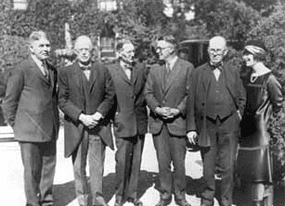
Some members and directors attending BTI opening ceremonies, September 24, 1924. (From left to right) Dr. William Crocker, Dr. John M. Coulter, Dr. L. R. Jones, Dr. R. F. Bacon, Col. William B. Thompson, and Mrs. Theodore Schulze.
William B. Thompson endowed the institute with $10 million, a veritable fortune in the 1920s. He hoped that this “seed” money would enable the institute to acquire the very best scientists, equipment, and supplies and then to develop relationships with industry and the government to help finance research. The licensing of institute patents with companies has helped balance funding during years of lean government support. Thompson believed that commerce and industry are beneficial to society and that commercial development of research results would spread the institute’s discoveries.
Laying the Foundation
By 1924 an interdisciplinary team of academic researchers had been assembled, and the facilities were finished. Many luminaries attended the dedication ceremonies on September 24 for the Boyce Thompson Institute for Plant Research (named not for Thompson himself, but for his parents Anne Boyce Thompson and William Thompson).
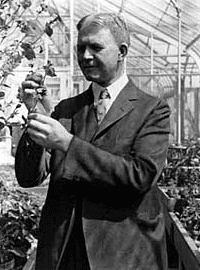
Dr. William Crocker
William Crocker, an associate professor of plant physiology at the University of Chicago, became the institute’s first managing director. He, Thompson, and other academic advisers spent several years planning the institute. Herbert H. Whetzel of Cornell urged Thompson to build the institute at a university so it could cooperate with university research programs, but Thompson wanted to be personally involved, and the institute was built across the street from his mansion in Yonkers, New York.
Early History
 From 1924 to 1932, Louis O. Kunkel studied the yellows diseases of plants about which neither the causative agent nor the method of transmission was known but that could destroy crops, orchards, and ornamental plants. Kunkel discovered that yellows disease in asters, which he thought was caused by a virus, was transmitted by leafhoppers. (Many years later it was discovered that the infectious agent was a phytoplasma.) To assist him in his work on the phases of the yellows and virus disease problems, he assembled a team of young scientists. Among them were Francis O. Holmes and Helen Purdy Beale. Beale conducted pioneering studies of plant viruses and, over many years, compiled and edited the Bibliography of Plant Viruses and Index to Research, published in 1976, well after her retirement in 1952. Holmes devised the “local lesion” assay, which identifies certain virus infections in plants, and discovered that plant varieties differ greatly in their susceptibility to various virus strains. By crossing the plants, he made the significant finding that resistance to a virus is inherited and linked to a single gene. Lela V. Barton studied seed storage and viability and became a prominent seed physiologist. For more than forty years she compiled information for her Bibliography of Seeds, published in 1967. Frank E. Denny, a plant physiologist from 1924 to 1950, headed a project on overcoming bud dormancy in potato. He was assisted by Lawrence P. Miller, a plant biochemist at the institute from 1929 to 1966. Miller was the first institute scientist to receive a government grant from the Atomic Energy Commission (now the Department of Energy) that resulted in the first use of radionuclides at the institute. In 1960 a National Science Foundation program was established to enable selected high school teachers to spend eight weeks working in a laboratory at the institute. In 1962, a similar program composed of third-year high school honor students was established. Miller directed both programs for several years. After his retirement he edited the three-volume series Phytochemistry, published in 1973.
From 1924 to 1932, Louis O. Kunkel studied the yellows diseases of plants about which neither the causative agent nor the method of transmission was known but that could destroy crops, orchards, and ornamental plants. Kunkel discovered that yellows disease in asters, which he thought was caused by a virus, was transmitted by leafhoppers. (Many years later it was discovered that the infectious agent was a phytoplasma.) To assist him in his work on the phases of the yellows and virus disease problems, he assembled a team of young scientists. Among them were Francis O. Holmes and Helen Purdy Beale. Beale conducted pioneering studies of plant viruses and, over many years, compiled and edited the Bibliography of Plant Viruses and Index to Research, published in 1976, well after her retirement in 1952. Holmes devised the “local lesion” assay, which identifies certain virus infections in plants, and discovered that plant varieties differ greatly in their susceptibility to various virus strains. By crossing the plants, he made the significant finding that resistance to a virus is inherited and linked to a single gene. Lela V. Barton studied seed storage and viability and became a prominent seed physiologist. For more than forty years she compiled information for her Bibliography of Seeds, published in 1967. Frank E. Denny, a plant physiologist from 1924 to 1950, headed a project on overcoming bud dormancy in potato. He was assisted by Lawrence P. Miller, a plant biochemist at the institute from 1929 to 1966. Miller was the first institute scientist to receive a government grant from the Atomic Energy Commission (now the Department of Energy) that resulted in the first use of radionuclides at the institute. In 1960 a National Science Foundation program was established to enable selected high school teachers to spend eight weeks working in a laboratory at the institute. In 1962, a similar program composed of third-year high school honor students was established. Miller directed both programs for several years. After his retirement he edited the three-volume series Phytochemistry, published in 1973.  Percy W. Zimmerman and Alfred E. Hitchcock joined the institute in the late 1920s and conducted research on plant growth regulation. They realized that halogenated aryloxyacetic compounds must play a role in regulating plant growth. The synthesis of 2,4-D and the discovery of its hormonal activity were significant advances in the understanding of plant growth that led to the development of rooting hormones and hormone-based weedkillers that kill weeds but not grass. Credit for the discovery of 2,4-D’s hormonal action is variously ascribed to (among others) Zimmerman and Hitchcock, DuPont researchers, a British team, and a gifted teenager, J. Carleton Gajdusek, who later won the Nobel Prize. No doubt with some supervision, Gajdusek synthesized 2,4-D during his summer job in a BTI laboratory. Zimmerman and Hitchcock published the first report of the hormonal activity of 2,4-D. They were also pioneers in studying the effects of air pollution on plants. Both of them won many scientific awards for their achievements. S. E. A. McCallan won recognition for his research on fungicides and air pollutants. He participated on the team that studied fungicidal action and effects of the pollutants sulfur dioxide and hydrogen sulfide on plants and microorganisms. He served as secretary and president of the American Phytopathological Society and received the society’s Award of Merit. In 1975, he authored A Personalized History of Boyce Thompson Institute, which covers the period from 1924 through 1974. McCallan served as corporate secretary from 1959 to 1973 and was affiliated with the institute for fifty-two years, from 1929 to 1981. 1923_2002 lists articles published by BTI scientists beginning with William Crocker in 1923.
Percy W. Zimmerman and Alfred E. Hitchcock joined the institute in the late 1920s and conducted research on plant growth regulation. They realized that halogenated aryloxyacetic compounds must play a role in regulating plant growth. The synthesis of 2,4-D and the discovery of its hormonal activity were significant advances in the understanding of plant growth that led to the development of rooting hormones and hormone-based weedkillers that kill weeds but not grass. Credit for the discovery of 2,4-D’s hormonal action is variously ascribed to (among others) Zimmerman and Hitchcock, DuPont researchers, a British team, and a gifted teenager, J. Carleton Gajdusek, who later won the Nobel Prize. No doubt with some supervision, Gajdusek synthesized 2,4-D during his summer job in a BTI laboratory. Zimmerman and Hitchcock published the first report of the hormonal activity of 2,4-D. They were also pioneers in studying the effects of air pollution on plants. Both of them won many scientific awards for their achievements. S. E. A. McCallan won recognition for his research on fungicides and air pollutants. He participated on the team that studied fungicidal action and effects of the pollutants sulfur dioxide and hydrogen sulfide on plants and microorganisms. He served as secretary and president of the American Phytopathological Society and received the society’s Award of Merit. In 1975, he authored A Personalized History of Boyce Thompson Institute, which covers the period from 1924 through 1974. McCallan served as corporate secretary from 1959 to 1973 and was affiliated with the institute for fifty-two years, from 1929 to 1981. 1923_2002 lists articles published by BTI scientists beginning with William Crocker in 1923.
50s and 60s
 George L. McNew became the second managing director in 1949, when Crocker retired. A plant pathologist, McNew did distinguished research concerning the chemical processes responsible for disease in plants. He was an able administrator who improved salaries and pensions at the institute, hired young researchers to join the aging staff, purchased modern equipment, and for the first time actively sought government (rather than just industrial) sponsorship for research. Leonard H. Weinstein, Jay S. Jacobson, Delbert C. McCune, David C. MacLean, Richard H. Mandl, and, later, John A. Laurence carried on the air pollution research begun by Crocker, Zimmerman, and Hitchcock. In the 1960s they undertook a very large program in this field that is still ongoing. Their research has encompassed many areas, including the effects of pollutants on the biochemistry, physiology, growth, and yield of plants and the development of air-monitoring methods and air-quality standards for numerous state agencies in the United States and several foreign countries. In 1978, Weinstein was recognized for his many years of leadership by being nominated as the institute’s first named scientist, the William B. Thompson Scientist. For more than two decades he directed research on the effects of fluoride on plants that was the foundation for the development of the largest scientific group dedicated to studying the effects of air pollution on crops and trees in the nation and perhaps the world. He continues to help industries comply with air-quality standards around the world. Weinstein served on the institute’s Board of Directors from 1973 to 1997, when he became an emeritus director. By 1967 the pollution of the Hudson River had become of great concern to conservationists. Edward H. Buckley, a researcher in Hudson River ecology for more than twenty years, was the project leader of the institute’s Estuarine Study Group, which compiled information on the biological status of the river and published it in 1977 in An Atlas of the Biologic Resources of the Hudson Estuary. Samuel S. Ristich and David L. Sirois were staff scientists on the project. This publication, edited by Weinstein, became an international resource on estuarine systems.
George L. McNew became the second managing director in 1949, when Crocker retired. A plant pathologist, McNew did distinguished research concerning the chemical processes responsible for disease in plants. He was an able administrator who improved salaries and pensions at the institute, hired young researchers to join the aging staff, purchased modern equipment, and for the first time actively sought government (rather than just industrial) sponsorship for research. Leonard H. Weinstein, Jay S. Jacobson, Delbert C. McCune, David C. MacLean, Richard H. Mandl, and, later, John A. Laurence carried on the air pollution research begun by Crocker, Zimmerman, and Hitchcock. In the 1960s they undertook a very large program in this field that is still ongoing. Their research has encompassed many areas, including the effects of pollutants on the biochemistry, physiology, growth, and yield of plants and the development of air-monitoring methods and air-quality standards for numerous state agencies in the United States and several foreign countries. In 1978, Weinstein was recognized for his many years of leadership by being nominated as the institute’s first named scientist, the William B. Thompson Scientist. For more than two decades he directed research on the effects of fluoride on plants that was the foundation for the development of the largest scientific group dedicated to studying the effects of air pollution on crops and trees in the nation and perhaps the world. He continues to help industries comply with air-quality standards around the world. Weinstein served on the institute’s Board of Directors from 1973 to 1997, when he became an emeritus director. By 1967 the pollution of the Hudson River had become of great concern to conservationists. Edward H. Buckley, a researcher in Hudson River ecology for more than twenty years, was the project leader of the institute’s Estuarine Study Group, which compiled information on the biological status of the river and published it in 1977 in An Atlas of the Biologic Resources of the Hudson Estuary. Samuel S. Ristich and David L. Sirois were staff scientists on the project. This publication, edited by Weinstein, became an international resource on estuarine systems.  Richard C. Staples joined the institute in 1952. He did pioneering work on the mechanisms that induce rust fungi to infect the leaves of host plants. He was part of an earlier team that described the first self-inhibitors of germination in rust spores. He later demonstrated that many but not all rust fungi can sense and respond precisely to the ridges of the stomatal guard cells through which they enter their hosts. During his career, Staples received the Alexander von Humboldt Foundation’s Senior U.S. Scientist Award and the Ruth Allen Award of the American Phytopathological Society (APS) and was elected a Fellow of the APS. In 1987 he was named the George L. McNew Scientist. He retired in 1991 and continues collaborative research with scientists at the New York State Agricultural Experiment Station. Zohara Yaniv came to BTI in 1967 to work with Staples as a postdoctoral research fellow. To gain a better understanding of the mechanism of obligate parasitism, Yaniv and Staples studied the ribosomal activities in uredospores of the bean rust fungus and their role in spore germination and senescence. For ten summers, Yaniv worked as an instructor—and later the director—in BTI’s NSF Student Science Training Program. She left the institute in 1978 when it moved to Ithaca. Projects to find ways to control bark beetles that were killing pine trees in western and southern forests were begun. To support this work, the institute acquired acreage in Grass Valley, California, and Beaumont, Texas. Jean Pierre Vité joined the staff in 1957 to direct research at the Grass Valley Forestry Laboratory. Beginning in 1963, Vité also directed the Beaumont Forest Laboratory. J. Alan Renwick and Patrick R. Hughes, then graduate students, joined Vité’s team. Together they discovered that male and female beetles (depending on the species) give off pheromones, chemicals that attract beetles of the other sex. The researchers used this knowledge to develop a form of nontoxic control that was produced commercially and is still in use. Renwick continued his work in chemical ecology, and his research in taste modification in crop-eating insects may lead to control measures that will protect crops by changing insects’ food preferences. Hughes studied insect viruses with a view to developing a nontoxic pesticide that will kill crop-eating insects. In the course of his work, he has developed an efficient, inexpensive system for rearing insect larvae at high density that may be of value in pharmaceutical production. Karl Maramorosch joined BTI in 1961. He is internationally known for his research in the transmission of plant viruses and mycoplasma-like agents by insects. In addition, he was an early pioneer in invertebrate cell culture. He won many awards, including the Wolf Prize for Agriculture in Israel, edited many volumes, and fostered many young scientists. In 1998, at the age of eighty-one, he received an Honoree Award from the Society for Invertebrate Pathology in Sapporo, Japan. Robert R. Granados, the Charles E. Palm Scientist, started at the institute in 1964. He was influenced to come to BTI by the research of Louis Kunkel and Karl Maramorosch. Granados established novel insect cell-culture lines that are in common use for recombinant protein production worldwide. He made important contributions to our knowledge of insect viruses and the molecular biology of the insect midgut. This work involved identifying new gene products for use in developing insect-tolerant transgenic plants. Jun Mitsuhashi and Eishiro Shikata did outstanding work in the 1960s. Mitsuhashi collaborated with Maramorosch in research in tissue cultures of insect carriers of plant diseases. Shikata became well known for his early research on pea enation mosaic, a disease of pea plants, and for his studies of plant viruses and their insect vectors, especially those associated with plant wound tumors.
Richard C. Staples joined the institute in 1952. He did pioneering work on the mechanisms that induce rust fungi to infect the leaves of host plants. He was part of an earlier team that described the first self-inhibitors of germination in rust spores. He later demonstrated that many but not all rust fungi can sense and respond precisely to the ridges of the stomatal guard cells through which they enter their hosts. During his career, Staples received the Alexander von Humboldt Foundation’s Senior U.S. Scientist Award and the Ruth Allen Award of the American Phytopathological Society (APS) and was elected a Fellow of the APS. In 1987 he was named the George L. McNew Scientist. He retired in 1991 and continues collaborative research with scientists at the New York State Agricultural Experiment Station. Zohara Yaniv came to BTI in 1967 to work with Staples as a postdoctoral research fellow. To gain a better understanding of the mechanism of obligate parasitism, Yaniv and Staples studied the ribosomal activities in uredospores of the bean rust fungus and their role in spore germination and senescence. For ten summers, Yaniv worked as an instructor—and later the director—in BTI’s NSF Student Science Training Program. She left the institute in 1978 when it moved to Ithaca. Projects to find ways to control bark beetles that were killing pine trees in western and southern forests were begun. To support this work, the institute acquired acreage in Grass Valley, California, and Beaumont, Texas. Jean Pierre Vité joined the staff in 1957 to direct research at the Grass Valley Forestry Laboratory. Beginning in 1963, Vité also directed the Beaumont Forest Laboratory. J. Alan Renwick and Patrick R. Hughes, then graduate students, joined Vité’s team. Together they discovered that male and female beetles (depending on the species) give off pheromones, chemicals that attract beetles of the other sex. The researchers used this knowledge to develop a form of nontoxic control that was produced commercially and is still in use. Renwick continued his work in chemical ecology, and his research in taste modification in crop-eating insects may lead to control measures that will protect crops by changing insects’ food preferences. Hughes studied insect viruses with a view to developing a nontoxic pesticide that will kill crop-eating insects. In the course of his work, he has developed an efficient, inexpensive system for rearing insect larvae at high density that may be of value in pharmaceutical production. Karl Maramorosch joined BTI in 1961. He is internationally known for his research in the transmission of plant viruses and mycoplasma-like agents by insects. In addition, he was an early pioneer in invertebrate cell culture. He won many awards, including the Wolf Prize for Agriculture in Israel, edited many volumes, and fostered many young scientists. In 1998, at the age of eighty-one, he received an Honoree Award from the Society for Invertebrate Pathology in Sapporo, Japan. Robert R. Granados, the Charles E. Palm Scientist, started at the institute in 1964. He was influenced to come to BTI by the research of Louis Kunkel and Karl Maramorosch. Granados established novel insect cell-culture lines that are in common use for recombinant protein production worldwide. He made important contributions to our knowledge of insect viruses and the molecular biology of the insect midgut. This work involved identifying new gene products for use in developing insect-tolerant transgenic plants. Jun Mitsuhashi and Eishiro Shikata did outstanding work in the 1960s. Mitsuhashi collaborated with Maramorosch in research in tissue cultures of insect carriers of plant diseases. Shikata became well known for his early research on pea enation mosaic, a disease of pea plants, and for his studies of plant viruses and their insect vectors, especially those associated with plant wound tumors.  Donald W. Roberts joined the institute in the 1960s. Roberts’s research on fungal diseases of insects worldwide included establishing new insect pathology teams in Brazil and the Philippines. In 1980 Roberts organized the Insect Pathology Resource Center, which included scientists from the USDA, Cornell, the New York State Agricultural Experiment Station, and the institute. The center supported training for national and international scientists, maintained a repository of insect pathogens, and performed basic and applied research. In 1996 Roberts became the Roy A. Young Scientist. Also in the 1960s, H. Alan Wood began his research on the physical and biological properties of plant and fungal viruses and then moved into the area of insect virology. His research has played an important role in the study of the basic biology and molecular genetics of insect viruses and in the designing and field testing of insect virus pesticides. On August 9, 1989, in Geneva, New York, he conducted the first field release in the United States of a genetically engineered virus. In the 1990s Wood researched methods to optimize the production of pharmaceutical proteins with insect viruses and to define the attachment of sugars to proteins by insects. Vlado Macko joined the staff in 1969. He and his colleagues discovered the chemical nature of host-specific toxins including victorin, HS toxin, and peritoxin. The work on plant disease models in which toxins play a central role led to the discovery of protectants and latent toxins and to the finding of victorin binding protein and its location in mitochondria and guard cells. He also characterized the chemical nature of self-inhibitors of spore germination in plant pathogenic fungi. Macko received the Alexander von Humboldt Foundation’s Senior U.S. Scientist Award. Dewayne C. Torgeson began his professional career at the institute in 1952 as a plant pathologist, working on an industrial project related to discovery and development of pesticides. Torgeson served as program director of the Bioregulant Chemicals Program from 1963 to 1985, as corporate secretary from 1973 to 1991, and as a member of the Board of Directors from 1978 to 1996, when he became an emeritus director.
Donald W. Roberts joined the institute in the 1960s. Roberts’s research on fungal diseases of insects worldwide included establishing new insect pathology teams in Brazil and the Philippines. In 1980 Roberts organized the Insect Pathology Resource Center, which included scientists from the USDA, Cornell, the New York State Agricultural Experiment Station, and the institute. The center supported training for national and international scientists, maintained a repository of insect pathogens, and performed basic and applied research. In 1996 Roberts became the Roy A. Young Scientist. Also in the 1960s, H. Alan Wood began his research on the physical and biological properties of plant and fungal viruses and then moved into the area of insect virology. His research has played an important role in the study of the basic biology and molecular genetics of insect viruses and in the designing and field testing of insect virus pesticides. On August 9, 1989, in Geneva, New York, he conducted the first field release in the United States of a genetically engineered virus. In the 1990s Wood researched methods to optimize the production of pharmaceutical proteins with insect viruses and to define the attachment of sugars to proteins by insects. Vlado Macko joined the staff in 1969. He and his colleagues discovered the chemical nature of host-specific toxins including victorin, HS toxin, and peritoxin. The work on plant disease models in which toxins play a central role led to the discovery of protectants and latent toxins and to the finding of victorin binding protein and its location in mitochondria and guard cells. He also characterized the chemical nature of self-inhibitors of spore germination in plant pathogenic fungi. Macko received the Alexander von Humboldt Foundation’s Senior U.S. Scientist Award. Dewayne C. Torgeson began his professional career at the institute in 1952 as a plant pathologist, working on an industrial project related to discovery and development of pesticides. Torgeson served as program director of the Bioregulant Chemicals Program from 1963 to 1985, as corporate secretary from 1973 to 1991, and as a member of the Board of Directors from 1978 to 1996, when he became an emeritus director.
1974 to 1980
Emeritus scientists Leonard H. Weinstein and Richard C. Staples wrote a firsthand account of the Boyce Thompson Institute (BTI) spanning a quarter century. This retrospective covers the move to Cornell and the people who contributed to the affiliation between Cornell and BTI. This colorful, “unofficial” account also covers breakthrough research from BTI’s recent history.
Preface
Originally, this period in BTI’s history was to be written by Dewayne C. Torgeson, scientist, Program Director, and Corporate Secretary. It was interrupted by his untimely death, and we were asked to take over the task in 2003. Other longtime colleagues were lost during this same period: Richard H. Mandl, environmental scientist, Dorothy Reddington, Director of Development, and Colleen Sloan, Secretary and Administrative Assistant for the Environmental Biology Program. We dedicate this history to them. If this continuation of the McCallan history (“A Personalized History of Boyce Thompson Institute,” which covered the years from dedication in 1924 to 1974) is not written in the traditional manner, it is because the actual events that make up a history always have degrees of humor, irony, and cynicism, as well as points of view. We wish to thank especially, Valleri Longcoy and Elizabeth Estabrook, who have been creatively helpful and collegial. This should not diminish the value of the willing help also provided by John Dentes; a critical review of a draft of the text by Alan Renwick and Bob Kohut; and other helpful support from Brian Gollands and Carl Leopold. Len Weinstein Dick Staples Boyce Thompson Institute May 1, 2005 This history is dedicated in their memory with appreciation for their important contributions to the BTI.

Clockwise from top left: Colleen Sloan, Richard Mandl, Dewayne Torgeson and Dorothy Reddington
Introduction

Colonel William Boyce Thompson 1869–1930
In 1917, immediately prior to the Communist revolution, Colonel William Boyce Thompson, a wealthy mining entrepreneur, visited Russia as part of a twenty-person mission appointed by the American Red Cross. It was one of President Wilson’s initiatives to bring peace to that region of the world. There, Colonel Thompson saw at firsthand the abject poverty and starvation of Russian peasants, and he became convinced that Russia might be stabilized if the production of food and fiber could be improved. In 1924, following the model of New York City’s Rockefeller Institute for Medical Research, Colonel Thompson founded and endowed the Boyce Thompson Institute for Plant Research with the objective “to study why and how plants grow, why they languish or thrive, how their diseases may be conquered, and how their development may be stimulated.” Although endowed from its inception, the breadth and scope of its research activities would not have been possible without outside support from individuals, foundations, and government agencies. In 1975, S. E. A. McCallan wrote “A Personalized History of Boyce Thompson Institute,” which included the institute’s history from its founding on September 24, 1924 to the period when we planned the move from Yonkers to Ithaca. In 2003, the authors were asked to continue the history of BTI from 1974 onward. We chose to cover the period up to 2000, leaving the period beginning in the twenty-first century to a future “historian.” There have been many changes in the institute during its “rebirth” on the Cornell University campus. One of these changes is the fewer number of women staff scientists (now called faculty). In the first fifty years, there were twenty-eight women scientists listed by McCallan as senior scientists, and even as early as 1924, at its founding, there were nine women scientists listed on the staff. In 2000, there were also nine women listed, two of whom were senior staff, the other seven research associates. From 1975 through 2000, there has been only one tenure-track woman, but she was not given tenure and left the institute. A number of women scientists had distinguished careers. Among the early senior staff, one must list Irene Dobroscky, a virologist who was at the institute in 1924. She studied the transmission of plant viruses (some of which are known now to be phytoplasmas) by insects in L. O. Kunkel’s laboratory, where each scientist worked independently. Helen Purdy (Beale) was also a virologist responsible for the precipitin reaction, and she published Bibliography of Plant Viruses and Index to Research. Lela Barton was a preeminent seed physiologist and was responsible for giving us Bibliography of Seeds and Seeds: Their Preservation and Longevity, among many other contributions. Norma Pfeiffer was an eminent taxonomist, classifying a number of plant families on the basis of megaspore characteristics. Sophia Eckerson was an accomplished plant pathologist and virologist. These are only a few of the women who contributed to the institute’s reputation in the early days of BTI. One hopes for a more realistic distribution of faculty in the future. Since 1975, there has been a strong emphasis by the institute on molecular genetics leading to a reduction or elimination of other disciplines. By the end of 2000, it appeared that programs for which the institute has been renowned in the past would be eliminated, in part because funding had become difficult to obtain for the more “traditional” sciences. Today, its research program has become adapted to the stimulating environment at Cornell, where it continues to change and take advantage of the sophisticated technology becoming available during the twenty-first century.
The End of an Era

Dr. George McNew
From his appointment on September 1, 1949 until his retirement on May 31, 1974, George L. McNew devoted all his energies to making BTI a leader in the plant sciences, developing strong programs in entomology, plant pathology (including virology), and environmental biology. At the same time, perhaps not consciously, he molded an institution that was tightly knit and had a family aura. It is difficult to describe this feeling of “family.” Dr. McNew, and his wife Elizabeth, took a great interest in the institute employees, from the maintenance workers to the scientific staff, although some people felt that this interest was excessive and overly paternal. The McNews showed their interest in several ways. They entertained often at their beautiful home overlooking the Hudson River. Both Dr. George McNew and Mrs. McNew were concerned with the employees’ welfare. In a financial emergency, it was not unusual for Dr. McNew to make a personal loan or, in a health emergency, both of them were known to pitch in with necessary housekeeping and cooking. On May 6, 1974, the Annual Meeting of the BTI Board was convened at the Hilton Inn in Tarrytown, New York, where the affiliation agreement with Cornell University was approved. This was followed by a reception in Dr. McNew’s honor, attended by board members, senior staff, and their wives. No managing director before or since McNew has dedicated so much time and energy to the administration of BTI or demonstrated such extreme concern for the scientific staff and other personnel. At the same board meeting, Dr. Richard H. Wellman was appointed to assume the position of managing director as of June 1, 1974. Wellman had close ties to BTI. He was hired by S. E. A. McCallan, after receiving his PhD from Washington State University, as a plant pathology fellow in a new Carbide and Carbon (later Union Carbide) project. Wellman was head of the project until 1954, when he left for the New York office, where he eventually became general manager of the Chemicals and Plastics Group of Union Carbide. He joined the Institute Research Advisory Committee in 1968 and was elected to the Board of Directors in 1969.
The Move to Cornell
The desire that the institute be associated with a university actually traces back to its founding, when William Boyce Thompson had his vision of creating an institution that he hoped would be to plant science what the Rockefeller Institute was to human and animal science. As a start, he asked advice from a number of prominent scientists. Among them was H. H. Whetzel, a professor of plant pathology at Cornell University, who suggested that this new institute be located in association with a university, preferably Cornell, but Thompson, although aware of the advantages of a university affiliation, had already decided it would be built across the street from his mansion, “Alder,” where he could observe its construction and operation. Little did he know that Whetzel’s proposal would someday become a reality. Further details of the institute’s founding years are described in S. E. A. McCallan’s A Personalized History of Boyce Thompson Institute (1975). In the 1950s, mild rumblings were heard from Dr. McNew and other staff members (which for convenience only, we shall hereafter refer to as “faculty”). At that time, both biological sciences and BTI were making great strides, and there was a greater realization that BTI was isolated from other research and academic institutions. Although there were a few graduate students from Columbia, Rutgers, Fordham, and Cornell universities who pursued their thesis research projects at the institute, there was no day-to-day interaction with colleagues from other institutions with whom ideas could be shared, discussed, developed, and modified, or collaborative studies could be carried out. Attendances at an occasional meeting was not sufficiently fulfilling, and talk of moving BTI to a college or university became a frequent subject among the faculty and administration. Indeed, the increased urbanization surrounding the institute, pollution from motor vehicles, and home heating (actually an advantage for the Environmental Biology program which stressed the effects of air pollution on plant life!) were becoming a serious problem. It was very difficult to modernize the building (because it was so well constructed that any change was exceedingly costly). But it also became clear among the administration that we would eventually have to seek another home.

Aerial View of The Boyce Thompson Institute Building and Grounds in Yonkers, New York. The property extended from the homes to the right of the photo, along the trees at the top, to the home visible on the left.
Despite occasional flirtations with moving, the first actual step in its relocation was offered in 1973 by Dr. Roy Young, a former graduate student of Dr. McNew’s and Vice President for Research at Oregon State University (OSU). Dr. Young began discussions with McNew and members of the BTI Board, and he interested OSU’s President McVicar, the Oregon governor, Tom McCall, and members of the Oregon state legislature. They were sufficiently interested that a bill was passed providing a sum of $6,750,000 to build and equip a headquarters for the institute on the OSU campus, and a formal invitation was sent to BTI’s Chairman of the Board, William T. Smith. The Executive Committee traveled to Oregon where they were feted for a couple of days and met with important university and state officials. Smith took a straw poll of the board members, which turned out to be very favorable to a move to OSU and he initialed a Memorandum of Agreement on May 15, 1973. This was confirmed in a letter from Dr. McNew to Roy Young of May 17, 1973, but McNew’s bias toward Cornell and his use of mild pressure in the negotiations became evident:
After we completed the visit to the Campus (OSU), I believe every member of our group was ready to accept Oregon as a future home for BTI provided there were firm assurances that the building would be provided and a suitable formal contract could be developed to implement the brief Memorandum of Understanding [actually it was a Memorandum of Agreement] upon that afternoon in Corvallis. Of course, there were two of us who felt that Cornell certainly had an advantage in general prestige and financial support for the project but we would not have insisted in exploring these possibilities further if we had a firm plan at Oregon State. The key people were definitely enthusiastic over what they saw in Corvallis and were ready to firm up an agreement along the lines of the Memorandum of Understanding as soon as the Board of Directors had approved the basic concept.
When the early negotiations with OSU became public, New York’s lieutenant governor, Malcolm Wilson, a native of Yonkers, moved to keep the institute in New York State, and along with Chancellor Boyer of SUNY, convinced Governor Rockefeller to bring a bill before a special session of the legislature in July that would provide a “biological laboratory, greenhouse facilities” on the Cornell campus. The bill was passed in the Senate, but encountered difficulties in the Assembly because some from Ithaca and some from the Yonkers area did not know what it was all about or did not want the institute to leave Yonkers. There were also allegations in the State Assembly that BTI was running an “exclusive and racist country club” in Stanfordville for BTI employees. What they were actually referring to was a 400+-acre farm that had been acquired for experimental purposes. At the behest of Dr. S. E. A. McCallan and others, a 1.3-acre pond was constructed and a cottage was built using volunteer employee labor. This cottage was designated for use by researchers and other employees for weekends or even week-long vacations following a specific set of rules and guidelines. It was hardly a country club, and certainly wasn’t racist; but it was a place where employees could go for short stays or drive up for the day, and it was the site of the BTI Annual Picnic, an extremely well-attended event that featured a great deal of eating, swimming, volleyball, softball, horseshoes, fishing, and other activities. At any rate, the allegations were somehow defused and the bill was passed under the able leadership of Assemblywoman Constance Cook. Following the invitations from both OSU and Cornell, there was a flurry of activity. Visits to OSU and Cornell were made by Secretary McCallan and the Executive Committee, and by Alva App, Dewayne Torgeson, and Leonard Weinstein representing the program directors. Reports were made by all visitors to the Board of Directors. The positive sentiment on the board to accept the OSU offer did not translate to the faculty, a great majority of whom favored Cornell. When examined dispassionately, Cornell appeared to be the superior choice. Some faculty, including Leonard Weinstein, decided that if OSU were chosen, they would not make the move. In Weinstein’s case, this had less to do with geographical than family reasons (aging parents and in-laws). The tip-off that BTI was favoring a Cornell affiliation became obvious in a letter from Dr. McNew to Miles Romney, the Vice Chancellor of the Oregon State System of Higher Education on July 30, 1973:
In all honesty, I should advise you that Governor Rockefeller introduced a bill into the special session of the New York State legislature on Wednesday afternoon, July 25, upon recommendation of the State University of New York, proposing Cornell University be provided with $8,500,000 to build and furnish facilities for Boyce Thompson Institute. . . . My latest advice is that the Senate passed the bill 54-5 but it is hung up in the Assembly by our local representatives who do not want us to leave Yonkers. . . . At the moment, Cornell expects the bill to pass but I have no data one way or the other.
And, as late as August 28, 1973, the Vice Chancellor of the Oregon State System of Higher Education requested that the president of that organization approve a change in the affiliation agreement with OSU. To make matters cloudier, after approval by the New York state legislature, the BTI Board reversed its earlier animus toward Cornell and voted 16-0 to accept its offer and move the institute to the Cornell campus. Dr. McNew, a man of many words, and in a voice that sounds a bit neo-Victorian, discussed the decision in a letter to Dr. Young dated September 14, 1973. This mea culpa is given in its entirety:
As Dr. Wellman has advised you, the general sentiment at our Board meeting on September 12 was to see if a satisfactory contract could be developed with Cornell that would gain the approval of the SUNY Board. The set of very definitive principles developed in negotiations between Dr. Wellman and Dr. Palm [Dean of Agriculture and Life Sciences at Cornell] and approved by officials at Cornell was sufficiently attractive to warrant their reduction to legal language, something which could not be done adequately earlier in the compressed time schedule imposed upon us. It is impossible to predict what obstructions and frustrations will be encountered in this process, but I concur with the Board that it had to be done before a final decision could be made. I was surprised to find that strong sentiment prevailed not to sign a provisional agreement with Oregon State while we were seriously negotiating with Cornell. Two members strongly objected to the morality and possibly the legality of entering into such an arrangement in poor faith and the others concurred in spite of Dr. Wellman’s and my explanation of your and President McVicar’s viewpoint. I sincerely hope this has not caused you any embarrassment because of the Emergency Board moving its session up before our meeting date. The growing sentiment for Cornell, as I see it, come from many considerations. The primary factor, of course, is that at long last they have a definite proposal with money to back it up to implement their suggestions to me of last October and their proposal of last December to the Board. Our Board was deeply impressed that they willingly modified their stand for complete consolidation to affiliation of two coordinated agencies on campus and even went so far as to seek status of BTI as an absolutely independent entity in its own facility provided by the State. The administration at the College of Agriculture had actually proposed to the State Department of Commerce and later to the State University that they build and assign the building to BTI without formal affiliation with the College, but this could not be legally done with State funds. Of course, Cornell had $8.5 million or $1.75 million more than you for construction of facilities. This position of strength did not overwhelm us; but they were in the process of accepting from the contractors on August 22 a veterinary research tower of 160,000 square feet constructed at a cost of $8.4 million. We could see exactly what could be obtained from their appropriation in constructing and equipping two thirds as much space for BTI with appended greenhouses. With all due respect to your fine facilities in the Bioscience building, their veterinary creation was out of this world in architectural design, tailored usefulness for various purposes, versatility and capabilities of modification, so it could be essentially as good 50 years from now as today. If any one thing swung some of us over to their column, it was this facility which included a remarkable array of furnishings and equipment as part of the construction cost. There were many supporting items such as a site where our greenhouses and labs could be attached directly, a mass of surrounding research activities within 100 yards in veterinary microbiology, plant pathology, entomology, soils and nutrition and bioclimatic facilities (which we can use gratis when desired), 24-hour service for our environmental installations, convenience to the Mann Library, a free shuttle bus service operating on a 15-minute schedule from our front door to all points on campus and ready access to large nearby parking lots. Convenience to business contacts was most favorable with two flights in each direction from the Ithaca airport (10 minutes from the proposed laboratory site) to New York City (53 minutes), Cleveland (1-1/2 hours), Pittsburgh (1 hour), Washington (1-1/2 hours) and Chicago (2-1/2 hours) [Ah, for the good old days!!] with major nationwide flights from Syracuse airport (70 minutes) and Elmira airport (95 minutes). Conferences in these cities could be held 9 a.m. to 5 p.m. without overnight delay. The staff preferences for Cornell undoubtedly had a strong bearing with Program Directors, Senior Scientists, Research Associates and Post-doctoral Fellows presenting an almost completely united front to the Board. While several [referring to a few faculty scientists and Board Members] would have liked to see us in Oregon for personal reasons, they seemed to feel the weight and strength of Cornell could not be denied as benefiting BTI. You should know and take pride in the reaction of everyone at BTI toward OSU as it was presented to us. Our Executive Committee and the visiting Program Directors were no less impressed than Dick Wellman and myself. The evidence of dynamic growth and progressiveness everywhere on campus was tremendous. The quality and scope of facilities and the dedication of your staff were evident everywhere. I believe that the warmth and friendliness of your administration, deans and scientists will live in our minds and hearts forever. No one should ever interpret the reverses on our Board as derogatory to OSU or the energy, skill and dedication with which you, Dean Krause and President McVicar presented your invitation and followed up in presenting your case. Our Board feels that we were presented with two generous and appealing alternatives from two of the most meritorious institutions in our field of science. It is almost a flip of the coin as to which should receive preference because one is fully established and progressing constructively while the other is excitingly dynamic and alive with possibilities for the future. Had we not been a foundation incorporated in New York State, had the State political structure not shown such determination to retain us in this State or had Cornell and the State University of New York not been so perceptive in analyzing the worries and needs of our Board, there is no question but that we would have signed the agreement with OSU last Wednesday and probably broken off negotiations with Cornell. I need not dwell on my personal frustrations during the past five months. Regardless of my personal desires and the warmth of our personal relations, I had to be guided entirely by what I believe to be to the best interests of Boyce Thompson Institute. If I had done less, I would not be worthy of the trust bestowed upon me by the BTI Board or the mutual respect and friendship which prevail between the two of us. Dick and I have debated item by item the considerations that have come before us step by step. While not agreeing in all personal appraisals, we have agreed decisively that we should be guided by what we see to be the most practical in achieving the best posture possible for BTI and its long range future and that personal considerations had to be ignored insofar as possible. I pray you will understand it has not been easy for either of us.
A Decision Is Made
Once the decision was made to move to Cornell, a building committee was formed, consisting of Donald Melhop, Chairman, Richard Lankow, Richard Mandl, Alan Wood and S. E. A. McCallan. Albany selected the architects, Ulrich Franzen and Associates. The building, exclusive of the greenhouse, was to be 63,132 square feet, somewhat larger than the building in Yonkers. The move to Cornell was scheduled for 1974, but New York State’s lagging economy postponed building construction, and we all wondered when, and if, we would ever make the move. Dave Cutting, a local businessman, community leader, and president of the Tompkins County Area Development Committee, was told by Arthur H. “Pete” Peterson, the Cornell treasurer, at a Citizen Savings Bank Board meeting that BTI was not coming to Cornell after all and, because of the state’s financial problems, had decided to go to Oregon. This rumor had only a passing relationship to the truth. What happened was that there were members of the board who felt strongly that Cornell had reneged on its promise and that we should renegotiate with OSU. When Cutting heard the news from Peterson, he went to see Raymond van Houtte, president of the County Trust Company bank and a community leader. They immediately flew to New York City, apparently under terrible weather conditions (so extreme that they weren’t confident that they would survive another day) to speak with the chairman of the New York State Dormitory Board, to whom they asked the question: If we can raise the money for the building, will you issue the construction bonds? Receiving a positive answer, they obtained pledges for $9.4 million, $0.9 million more than required. Cornell University faculty and staff pledged $1.5 million, local banks $3.5 million, regional banks $2.4 million, and BTI $2 million. In the final tally, the construction bonds were oversubscribed, and BTI was let off the hook and not required to invest any of its endowment funds. The bonds were to pay an interest rate of 9 percent but, when issued, paid 8 percent and ended up being called by the state in two years, much to the disappointment of the bond holders. In preparation for the move, members of the Building Committee, administrators, program directors, other scientists, and key maintenance personnel made numerous trips to Cornell to attend meetings of various kinds; present talks to Cornell faculty, staff, and students about BTI, its history, and goals for the future; and look for housing, check school quality, neighborhoods, and so forth. Dewayne Torgeson especially made trips to negotiate details of the Affiliation Agreement (see Appendix IX). Donald Mehlhop and Richard Mandl were the two most involved with the building’s construction and attended many meetings with the architects and building contractors and subcontractors until the building was completed. As an aside, Don Mehlhop had been a submarine commander in World War II and was an experienced leader of men (actually, he and his submarine sat at the bottom of Tokyo harbor when Japan surrendered). Dick Mandl was a faculty member in the Environmental Biology Program who had remarkable natural talents for instrument design and construction basics. Mandl took primary responsibility in making certain that the plant growth facility and scientific needs were suitable. They made a strong team (although accompanied by occasional loud disagreements) that helped to develop a building that was not only beautiful and award winning, but also functional, and that met, and continues to meet, the needs of the staff. Scientists who made the move to Cornell were allowed to select and design their offices and laboratories. Years later, renovations were made because of changes in equipment and style of furnishings, as new scientists arrived.
A New Home in Ithaca
Building construction started in 1977 and, by October 1978, nearly the entire scientific staff, many technicians, the building superintendent, and the head of the maintenance department began moving from Yonkers into the new building. A Yonkers mover, the 7 Santini Brothers, was contracted to move all of us who chose to relocate in Ithaca. There were few restrictions on what and how much we could move. Some people even moved dozens of clay pots and lumber. For a few years after the move, 7 Santini Brothers boxes were as common in the new building as cockroaches were in the old one. Occasionally one still runs onto 7 Santini Brothers boxes around the institute and in many basements and attics. Upon Colonel Thompson’s death, the institute was left a number of paintings from the Thompson estate and most, if not all, of them could be found hanging in the building—in administrative offices, the library, the entrance foyer, and a number of scientists’ offices. Just prior to the move to Ithaca, Park Bernet, a New York auction house, catalogued and made cost estimates of the paintings for auction. Len Weinstein was fond of a small still life (signed “Hurst”) in his office in an ornate gold frame. The appraiser valued it at $300. Weinstein would have been allowed to buy it at that price, but he decided that $300 was too much money for such a small painting. Later, it fetched $8,000 at auction, a foretelling of Weinstein’s future financial dealings (divestments).

The Current Boyce Thompson Building
During trips before the move and after our arrival, the Cornell community warmly welcomed us. Somehow, though, Cornell personnel, realtors, and the Ithaca community as a whole had the impression that we were being paid outrageously high salaries. In fact, before the move, realtors often arrived in Yonkers with photographs of homes available for purchase, invariably mansions and accompanied by, “We understand this is the kind of home Institute people will be looking for.” This, of course, was light years from the truth. One of the photographs shown to Weinstein was of the mansion that is now Cornell President Lehman’s home. After being revived, Weinstein said that he didn’t want to heat more than fifteen rooms. As it turned out, the institute raised most salaries to conform generally to Cornell’s pay scale. This may have been due partly to the wording regarding comparability in the affiliation agreement with Cornell (see appendices). The first few months after the move were heady indeed. The excitement of being affiliated with a university, let alone a great one, was exhilarating. The Environmental Biology Program was especially welcomed because of its reputation as one of the best and largest air pollution groups in the United States, and because there was no equivalent group at Cornell. Their experimental farm of twelve acres, just adjacent to Route 366, was set up and ready for the summer following the move. Many BTI scientists were also invited to become adjunct professors of various departments, among which were Plant Pathology, Natural Resources, and Plant Biology. No one was invited to join Ecology and Evolutionary Biology or Entomology. There were very few sour notes associated with the move, but those that did present themselves were based on the exaggerated salary story and complaints that SUNY turned over to us outsiders, a beautiful building to occupy while so many other building at the College of Agriculture and Life Sciences were old and substandard. This was true. The dedication ceremony for the new building was held on April 24, 1979, in the Law Auditorium at the School of Veterinary Medicine. At the time of the dedication, BTI’s research was concentrated in five areas: biological nitrogen fixation, biological control of insects, air pollution effects on agriculture and forestry, plant stress, and the development of bioregulant chemicals. On April 25–26, 1979, there was a Dedication Symposium, “Linking Basic Research to Crop Improvement Programs in Less Developed Countries,” cosponsored by Cornell University and partially supported by the Ford Foundation. The program stated that it was “A celebration of affiliation with the N.Y. State College of Agriculture and Life Sciences at Cornell University.” Richard Staples organized and chaired the symposium, and the subjects were clearly selected to be a template for the “new” directions of BTI under its new Managing Director, Richard Wellman. It did not take long before we noticed a discernible change in BTI’s reputation as Cornell’s incandescent standing began to rub off on us. This is still true today. As McCallan (1975) stated in his history of BTI:
Mr. Searls, a rugged individual of the old school, was to become something of a stormy petrel who was not satisfied with the status quo at the Institute and wanted to shake things up for the better.
Fred Searls, who liked to list himself as “Mining Engineer, 14 Wall Street, New York City” worked for Colonel Thompson in mining explorations around the world and eventually became president of Newmont Mining Corp., the organization founded by William Boyce Thompson. Searls often told stories about “fighting off bandits” during mineral explorations in China, which, when told in full, would undoubtedly be far more interesting than this history. At McCallan’s second BTI annual meeting as a director (in 1947):
he [Searls] called the attention of the Directors to the ravages of beetles and other insects to pine and other timber in the Northwest and desired to know whether the Institute could save the situation. Dr. Crocker (then Managing Director) did not take kindly to Searls’ suggestion and replied “that the U.S. Government was already spending huge sums for this purpose” . . . Word filtered down to the staff that the new Member wanted the whole Institute to work on “reforesting the Rocky Mountains”. Thus at this point, Fred Searls became in the eyes of the staff something of a villain on the Board. Little did we think that in 1953 he would become Chairman of the Board.
As Chairman of the Board, Searls was persistent in pushing the institute toward a bark beetle program. He also pressured the institute into other things. For example, he prodded the institute into investigating, for his friend Bernard Baruch, the value of cellular therapy, a cult medical treatment to ensure perpetual youth begun in 1930 by a Swiss physician, Paul Niehans. Earlier, Niehans had been involved in the infamous transplantation of monkey glands for a similar purpose. “Graduates” of the cellular therapy program included Konrad Adenauer, Pope Pius XII, Gloria Swanson, and many other notables. (Winston Churchill applied but was turned down because of his inveterate cigar smoking and drinking.) Assigned by McNew to the “investigation” were Walter Tulecke and Leonard Weinstein. Although little was accomplished, they attended several meetings in New York City of a cellular therapy group, met many “interesting” people (including Wolfgang Goetze-Clarens, a disciple of Niehans’s, who was fawned over outrageously all that evening). The New York Times the next day published a list of foreign doctors, including Goetze-Clarens who were caught falsifying their medical exams. (Some youth doctor!) It was not all a complete waste because Tulecke and Weinstein ended up having Thanksgiving dinner in South Carolina with Searls, Baruch, and Baruch’s “nurse” (who was called “Navarro”) not on the traditional Thursday but on the previous Tuesday! Details of the Weinstein/Tulecke escapade are not germane to this document, but they could be considered adventures in the occult. As we departed for the airport, Baruch gave each of us a bag of persimmons. It was Weinstein’s first (and last) persimmon and his only Thanksgiving dinner with Bernard Baruch! Fortunately, the story of BTI’s involvement with the founding youth doctor, Paul Niehans, and how BTI was able to extricate itself from being further entangled in this activity, is a long story, but the “youth” doctors are still in business.
The Stanfordville Farm

Annual picnic at Dutchess county farm. Left to right: Jane Beardo, Joan DeFato, Jill (Goldman) Mancini.
Although we were far from being a “forestry institute,” Dr. Clyde Chandler had been carrying on a breeding program on larch at the institute arboretum, located about a mile from the main building. But in 1956, when the New York State Thruway Authority condemned and purchased 52 acres of its best land, which included the nursery area, the arboretum was doomed. BTI sold the remaining land for what seemed to be a pittance, after which it changed hands several times, each sale at a progressively higher price. This may have been a portent of future institute land dealings. The area condemned by New York State is now the Yonkers toll booth area of the New York State Thruway. The remaining property eventually became a Westchester County park. In order to continue the larch breeding program, and perhaps for other reasons, the institute acquired a 441.5-acre farm in Stanfordville, Dutchess County, New York in 1959. Dr. Chandler’s larch seedlings were transplanted to a 17-acre parcel on the farm. By diverting a stream and creative use of a bulldozer, a small lake of 1.3 acres was formed. A cottage was built, ostensibly for the use of researchers, although the lake and cottage became an employee benefit and the site of the annual institute picnic. Jerry Way, who supervised activities at the Yonkers arboretum, moved to a house nearby and took over everyday management of the farm. Later, when the New York State legislature was debating a bill for funds to construct the building at Cornell for our use, the farm was used to accuse BTI of running an exclusive and private “country club.” With the impending move to Cornell, the property was sold in December 1975 and March 1976 for a total of $297,000. Contrary to most past and future BTI land dealings, there was a net profit to the institute of $193,800!!
The BTI Home Campus and Lenoir
At the Annual Meeting of Members of BTI on May 12, 1975, the move to Cornell appeared to be more and more imminent and the members spent most of their time discussing the divestment of land: properties in Beaumont, Texas; Grass Valley, California; Stanfordville, New York, and the institute’s home campus, which now comprised a parcel of about 130 acres, including the Hudson River Country Club (which surrounded the institute’s original campus of 7 acres on three sides), and was formerly restricted (which meant no Jews, blacks, Latinos, and few Catholics) and Lenoir, an estate of 16 acres across North Broadway from the institute and immediately north and adjacent to the beautiful Thompson estate, Alder. Lenoir and the Hudson River Country Club were acquired when Dr. Orrin Wightman (who became the heir to the estate and country club through marriage) died and the institute exercised its right of first refusal as had been agreed upon at an earlier date. The original acquisition of the property seemed essential to the institute’s future at that time, but it became a liability when the real estate market turned sour and we had to pay taxes to the City of Yonkers for all but a 40-acre parcel that was incorporated as an experimental farm and part of the main campus. There were many suitors who wanted to continue the golf course and country club, start a new university, or build a shopping center, each of which failed because they were not financially sound, far beyond our capabilities, or vigorously opposed by neighbors. (Even today, there is a move to tear down the original institute building and replace it with modern medical offices, a health club, and, allegedly, a Dunkin’ Donuts shop). Naturally, there is also an opposition group that wanted the building to be declared a historic landmark home. The building will not be demolished, but will not become a historic landmark. In the meantime, the U.S. economy went into a steep decline and there were few serious customers for the land. Also, the city of Yonkers had changed the zoning of the property to Industrial Park, which more than doubled the taxes. With the initial investment in the land of $2,960,000, taxes for several years, and loss of interest on the capital, the institute became desperate to find a buyer. It was finally agreed to sell the property to the Robert Martin Corporation, developers of executive parks. At the May 12, 1975 meeting, the members authorized the Executive Committee to conduct negotiations to sell the property for a price that most members and directors felt was too low, but had to be accepted because time was short and there were no other prospects. At the Executive Committee meeting of June 19, 1975, recognizing the poor condition of the real estate market and the somewhat awkward location of the property, the committee voted nearly unanimously to sell the property (without the Lenoir estate) for $2,300,000. Dr. McNew cast a negative vote stating that the price was much too low and that we should continue to seek out purchasers. As an aside, one of us (LW) was a close friend of the attorney for Robert Martin. He rarely spoke of anything associated with his legal activities, but because of our friendship he told me that the institute lawyer, claiming that he was too busy to write the contract, asked him, the Robert Martin lawyer, to write it, a monumental error in this kind of negotiation. After that, the lawyer friend said, it was like “taking candy from a baby.” The Lenoir property (a mansion and 16 acres of land overlooking the Hudson River) was sold to the County of Westchester in 1977 for $504,000. These negotiations were not the last in the institute’s policy of divesting land at a large real or potential capital loss. In this case, considering the original cost of acquiring the country club and Lenoir, the selling price, taxes on much of the property for eight years and the lost interest from capital, a conservative estimate of the loss to the institute’s endowment was about $8,000,000.
The Beaumont, Texas, Laboratory
Bark beetles were raising havoc with longleaf and loblolly pines in the South and the institute was asked by the Southern Forest Research Institute (a consortium of several lumber companies) to establish a laboratory on 390 acres of low-lying land west of Beaumont near the village of Sour Lake. Patrick Hughes, a remarkably versatile entomologist, who retired from BTI in 2003, and Alan Renwick, an outstanding chemical ecologist, were resident or part-time scientists there, with Jean Pierre Vité, who came to BTI from Göttingen, Germany, as the overall director. Vité was a brilliant and dynamic entomologist. The group found, among other discoveries, that the pheromones, frontalin, trans-verbenol, and verbenone were produced by three species of Dendroctonus bark beetles and that synthetic samples of these compounds were useful in concentrating the beetle attacks for exercising control measures. As McCallan (1975) said, the Southern Forest Research Institute “decided to dissolve and withdraw their support in September of 1974. Presumably they felt that the major goals had been accomplished and they were not about to support long-range basic research especially when the U.S. Forest Service was funding such.” The BTI land and holdings were sold, and the sole resident scientist, Patrick Hughes, was transferred to Grass Valley. According to contemporary sources, the land was sold for a price far below its market value.
The Grass Valley Laboratory

BTI Bark-beetle laboratory building at Grass Valley, California
As mentioned earlier, Fred Searls Jr., the Chairman of the boards of Newmont Mining and of BTI was insistent that something be done about the damage being caused to forests and shade trees by various species of bark beetles; the estimated damage being about five times that caused by forest fires. Because it was felt that a basic study of bark beetles and forest trees could not be accomplished in greenhouse and laboratory studies, Mr. Searls proposed that the North Star Gold Mine property, a tract of 660 acres south of Grass Valley, California, be given to the institute for future studies. This was augmented by a gift of 20 acres and a house by Mr. James D. Hague, and the purchase of two adjoining tracts lying along the southern boundary, giving a total of 740 acres for research. Funding also came from the Margaret T. Biddle Foundation (Margaret Biddle was the only Thompson child) and the institute endowment. Title to the property was acquired in December 1957. The director of the laboratory (as well as the one in Beaumont, Texas) was again Jean Pierre Vité. Alan Renwick worked both there and at Beaumont, Texas with Vité. Patrick Hughes also worked there after being transferred from Beaumont. The forest consisted mainly of ponderosa pines with some black oaks, the only broadleaf species. A summary of the research carried out and their trials and tribulations has been summarized earlier (McCallan, 1975). A decision was made to move the activities of the Grass Valley operation to OSU. In 1977, the Grass Valley property was under contract to Robinson Enterprises for $840,000. Several board directors and scientists who had worked there protested this price. BTI had been receiving about $100,000 per year in timber sales and another $100,000 per year in sales of rock from the earlier mining activities, but the protests were to no avail and the land was sold. This was another “feather” in BTI’s land-dealing misadventures. Despite the fact that there was no financial loss, because the land and buildings had been donated to the institute, there was a loss in what could have been received for the property.
The Nepera Park Farm
From its early days until it was sold, the institute’s farming activities took place at the 25-acre Nepera Park Farm, located east of the Hudson River Country Club boundary. The farm had been used extensively by Percy W. Zimmerman and A. E. Hitchcock during the period when they were actively studying rooting and other plant hormones. It was also used for field testing of pesticides and other miscellaneous activities. But its greatest use was by the Environmental Biology Program for studying the effects of air pollutants on plant growth, yield, and quality. After the institute acquired the Hudson River Country Club property, the farm activities were moved from Nepera Park to a somewhat larger tract behind the institute building. The Nepera Park Farm was then sold to the Gestetner Corporation. They, in turn, sold the property to the Wilmorite Corporation, a large real estate development company. Wilmorite, apparently feeling a downturn in the economy and not seeing an immediate use for the property sold it to Consumer’s Union for a headquarters building. Thus began a saga that led to a lawsuit against the institute and culminated in a settlement never made public. The story began when Consumer’s Union, in considering the purchase of the property from Wilmorite, insisted that it must be a pristine, uncontaminated parcel. Wilmorite contracted with an environmental consulting firm to take soil samples for wide-spectrum analysis. Traces of chlordane were found in several cores, particularly in one. Concerned that they might lose the sale, Wilmorite had the areas where chlordane was found excavated and sent the potentially contaminated soil to a special incinerator where anything organic would be decomposed. Wilmorite then asserted that the problem was caused by BTI and filed suit for reimbursement of costs of more than $3 million. Dr. Ralph Hardy was the president of the institute at the time, and he was energized by this claim because of its potentially negative impact on the institute’s endowment. BTI retained a law firm in Albany (Whiteman, Osterman & Hannah, LLP) that specialized in environmentally related litigation. Our insurance company initially asserted that coverage did not exist and, at this point, the records of further actions have been blurred intentionally. Even as a board member, Leonard Weinstein was not informed of the actions. The denouement was that our insurance company paid a significant portion of the costs, but BTI was responsible for an amount that probably reached seven figures.
The Richard Wellman Years (1974–1980)

Richard H. Wellman, Former Managing Director
Richard H. Wellman was BTI’s third managing director. He was no stranger to the institute, having been hired by the first managing director, William C. Crocker in 1939 as a fellow in the new Carbide and Carbon Chemicals project. The goal of the project was to test organic chemicals produced by the sponsor (or its parent company, Union Carbide) for biological activity as fungicides (and later as insecticides, miticides, herbicides, plant growth regulators, etc.). The project grew significantly over the years. From these screening efforts, the most important compound to see the marketplace was the insecticide Sevin. Unfortunately for BTI, the patent was owned by Union Carbide. During the project’s tenure, about 14,000 compounds were screened. (This period was during the heyday of the introduction of new pesticides.) During the McNew years, industrial groups were allowed to establish “fellowships” to carry on research or chemical screening, or both. After the Union Carbide project began, the institute had projects sponsored by the Ethyl Corporation (later changed to Diamond Shamrock), and a few smaller assorted projects. Dewayne Torgeson headed the miscellaneous projects; and David Sirois and Earle Richard H. Wellman, former managing director, were faculty scientists. In many ways, these screening projects were not too unlike the aborted project begun by Charles Arntzen in the 1990s with the Axis Corporation, a kind of equivalent in molecular biology, except that it went bankrupt. In 1954, Wellman left the institute to take up the position as Assistant Manager of Fine Chemicals at Union Carbide Corporation, but his contacts with the institute continued. He was appointed to the Research Advisory Committee in 1968 and a member of the Board of Directors in 1969. At the BTI Annual Meeting of Members and Directors on July 26, 1973, Wellman was nominated and elected to succeed Dr. George McNew as managing director, a position he assumed on June 1, 1974. At this same meeting, Leonard Weinstein was elected to the Board of Directors as the first “faculty” representative. Weinstein resigned as a director in 1992 at the same time as Dewayne Torgeson. (Weinstein was not only the first representative of the faculty elected to the Board, but also the last. In 1999, the chairperson of the Executive Committee proposed and passed a by-law that would eliminate any future election of faculty representatives to the board. When asked why this was being proposed, the response was that this is the way modern corporations operate. Because we were not a modern corporation, a more plausible explanation might have been to provide an opening on the board for a new director with business and industry contacts and/or “deep pockets.”) The following are the concluding remarks made by McCallan (1975) in A Personalized History of the Boyce Thompson Institute.
[Dr. Wellman] is well equipped to handle Institute affairs having spent his first 14 professional years on the Institute staff and all subsequent years in industrial management with Union Carbide culminating in a vice presidency. He is faced with grave problems: the necessary increase in Institute income, and a reasonable solution to the real estate holdings. The broad question of improving world agriculture and the possibility of the Institute’s contribution is being studied. Plans satisfactory to all parties for the new building at Cornell must be developed. Already some changes in operation are evident, the Program Directors have been given more responsibility, meetings are short and to the point, the new Managing Director is a listener. May this new era rank in accomplishments with the earlier ones and the years with Cornell be fruitful and happy.
In the internal annual report for 1974, Wellman’s first, the minutes stated that the board Executive Committee approved a 12 percent salary increase for faculty, an almost presidential amount, but this move was probably in anticipation of the move to Cornell. Wellman mentioned in the report that:
During the year we have devoted a great deal of effort to selecting projects in International Agriculture where our scientists have the expertise to make a contribution and where there are good possibilities of obtaining outside funding.
As will be seen subsequently, our efforts in International Agriculture were only modestly successful, realized in part primarily by Alva App and Donald Roberts. Wellman’s first years were difficult ones financially. Inflation was high and the stock market had slumped. Foundation endowments had been seriously eroded and government agencies were experiencing severe cutbacks in funding. This may have been instrumental in Dr. Wellman’s move into International Agriculture, although it was also consistent with the institute’s original goal to increase food production on a global scale. After arriving at the new building at Cornell, several months were spent unpacking and setting up the new facilities. Program directors and other faculty members were given more responsibility, especially in maintaining existing grants and finding new sources of income because the move, as expected, added to the already significant drain on the endowment. Meetings were blessedly short, Dr. Wellman believing that after one hour meetings became repetitive and soporific. But, within the first couple of years on the Cornell campus, it became obvious to many people that Dr. Wellman’s health was less than perfect. His movements became somewhat uncoordinated and halting, and some wondered if he had left Union Carbide to take the position at BTI because of early symptoms of his condition, which, sadly, turned out to be Parkinson’s disease. It became worse during his tenure and near the end of his five-year appointment, he was having balance and other problems. Dr. Wellman’s tenure as managing director continued the institute’s tradition of supporting a multifaceted research program and was characterized by strong individual endeavors. His background was more in industry than academics, government grants were tight and his contacts were more in the international scene than in granting agencies, so it was natural to emphasize the latter direction. Dr. Wellman retired as managing director on August 31, 1980, but stayed on as a member and director of the board and was also appointed as a consultant to the new managing director. The consultancy was for five years at a significant stipend each year. He was also allowed to purchase the house he occupied from the institute at fair market price.
The New Institute Building at Cornell University
Plans for the new building at Cornell were received with great enthusiasm because the design, unlike the preliminary box-like design for a building at Oregon State, appeared very avant-garde. According to the plans for construction, the building should have been available in 1976 but, as with many best-laid plans, there was a fiscal crisis in New York City that was quickly reflected in New York State’s financial situation, resulting in deferment of the building’s construction. The possibility of funding from a consortium of banks, private citizens, Cornell employees, and so forth, as discussed earlier, was a major topic at the February 17 Executive Committee meeting. William Smith, the board chairman, emphasized that the bonds would be moral obligation rather than full faith and credit bonds of New York State, backed by the university’s tuition and hospital income and a small endowment. Arthur H. Peterson, the Cornell University treasurer indicated that if BTI would agree to purchase the bonds, the payment would not come due until the building was completed. The institute’s brokers estimated that, because of the state’s financial problems, the bonds would sell in the range of 80–85, not an ideal price. It was estimated that the bonds would probably be issued in the 9 or 9.5 percent range with a thirty-year maturity. (Actually, they were issued at 9 percent, but the rate was dropped to 8 percent after the first year.) Although a risky investment, the Executive Committee was of the opinion that the state, and if not the state the federal government, would not allow the bonds to default. Dr. Wellman reviewed the institute’s alternatives at this point and stated that the institute had three options: (1) we could sit by and hope that in a year or two the state would allow SUNY to initiate new university construction; (2) we could attempt to get a two-year delay in vacating the Yonkers buildings from the Robert Martin Corporation, the purchaser of the land; or (3) we could drop the Cornell affiliation and attempt to find a similar type of arrangement with another university. But there were negatives associated with each of these options. They would delay our moving from Yonkers and, of paramount importance, would prevent us from realizing an anticipated annual savings of $500,000 in services that would be provided by Cornell if we moved. The actual move was now becoming even more tenuous. In a series of meeting of the BTI Executive Committee and the BTI Board on February 17, 1976, the problems posed by the State of New York financial problems cast serious doubt on whether we would continue to work toward a move to Cornell. Christian Hohenlohe, the great-grandson of William Boyce Thompson, pointed out that we had acted in good faith in agreeing to affiliate with Cornell and that it was their responsibility to find a solution to the problem of financing the building. As a trustee, he was reluctant to commit such a large part of our capital to purchasing bonds that he considered to be a risky investment. Robert Fulton, the chairman of the Executive Committee, was also against purchasing the bonds. He went further and said that we had an agreement with Cornell, entered into by us in good faith, and proposed that we not accept anything less than what was offered and approved originally. Later that day, at a special meeting of members and directors, this issue was brought up again. A number of options were discussed, among which was one to abide by our affiliation agreement with Cornell and SUNY and wait two years until the state was in a more favorable financial position and could construct the building, or, we could seek a similar arrangement with another university. Chairman of the Board William T. Smith pointed out that both options would require seeking an extension from the Robert Martin Corporation for vacating the building because we were now in danger of becoming homeless, having sold all our land holdings and our home for more than fifty years! There was much give and take at this meeting because of its importance to the future of the institute. Leonard Weinstein, who represented the institute staff on the board, pointed out that the previous years of poor finances and the tumult related to a possible move had brought about marked changes in the quality and quantity of research. More and more faculty time had been spent in seeking funds and, frequently, as a matter of necessity, accepting routine and mundane research projects. He said that every effort should be made to increase income from the endowment. Furthermore, a move to Cornell would help morale and strengthen us scientifically and financially. Responding in part to Weinstein, C. Wadsworth Farnum expressed his opinion that the risk of purchasing $3.5 million in bonds was worth it “since we would be placing the Institute for the long term in the right climate to do good research.” By contrast, Fulton was concerned with Weinstein’s comments and pointed out that there were also hazards in associating with a university “with all their [Cornell’s] financial problems.” He went on to again oppose putting an investment such as New York State bonds in our portfolio and suggested that we inform Cornell that we “either get the deal originally signed or we look elsewhere.” Of course, “looking elsewhere” at this point was only hypothetical. The deal with OSU, for example, would have had to be completely renegotiated and the Oregon legislature would have to reauthorize the invitation and construction monies. And, of course, the enthusiasm for BTI may have waned after we turned down their offer and they were never able to throw their bridal bouquet. So, the board meeting ended with uncertainty, but with a consensus that we not purchase state bonds and that the board officers be authorized to explore other possibilities. Before adjournment, Rodman Rockefeller, a son of Nelson Rockefeller, the New York State governor, and Dr. Roy A. Young, Vice President for Research at OSU, were elected as directors. Young’s election may have been partly an apology for our rebuff of OSU, but he also had long and close ties to the institute. (During the next five years, Mr. Rockefeller rarely came to meetings and the largesse bestowed upon him in the form of a group of magnificent Japanese threadleaf maples and a number of large hybrid rhododendrons far exceeded that received in return. By contrast, Dr. Young faithfully attended meetings and was destined to become BTI’s fourth managing director. Rockefeller resigned on May 8, 1980 and was replaced by Dr. Sterling Wortman, Acting President of the Rockefeller Foundation). At the Executive Committee Meeting on May 14, 1976, and sounding like a broken record, there was a strong feeling that BTI should push Cornell for a solution, “but unless we had a good answer from Cornell by the end of August, we should look elsewhere.” Although Christian Hohenlohe agreed with this approach, Mr. Fulton thought that we should immediately look elsewhere for the best arrangement. Later that day, meetings of the members and directors were held. At this stage, Cornell was suggesting that BTI purchase $2 million of certificates of deposit from a bank, which in turn would purchase an equivalent amount of tax-exempt bonds. Dr. Wellman was in favor of this approach. The “missing” $1.5 million was to be purchased by local Ithacans. Chairman Fulton restated his opinion that we did not have a viable agreement with Cornell and therefore should not use any institute funds. Dr. McNew, Mr. Farnum, Mr. Hohenlohe, and Mr. Smith indicated that they were in favor of the Cornell proposal and that view was carried. It was now up to the board, which met in a special session on July 21, 1976. Chairman Smith announced that pledges from banks in Ithaca and nearby and the Cornell and Ithaca community to purchase $6.5 million in New York State bonds had been obtained. If the institute would commit $2 million of the bonds, the state would be enabled to issue a call for bids so that construction could begin in the fall. He recommended approval. The architect of the building, Ulrich Franzen, indicated by letter to Dr. McNew that the total of $8.5 million would still be sufficient for construction of the building. At last, the board unanimously approved purchase of the bonds and the institute was on its way to the beginning of a new era. Did the institute purchase bonds? After all the controversy on the board, the answer is “no.” Because of a more favorable market for New York State Agency bonds, we were not required to purchase any.
Cornell Reality Sets In
Now that the move to Cornell was to be a reality, the institute began a serious review of its portfolio. In past years, there had been intermittent calls from members of the board to place our portfolio under professional management. At the time, we had one or more financial advisors to assist Chairman Smith in portfolio management. So at the December 6, 1976, meeting of the Finance Committee, the head of BTI’s team of financial advisors, Mr. Ramsay Wilson, President of Schroeder Naess & Thomas, stated that he and his colleagues saw no immediate problems in endorsing the institute’s three major holdings, Newmont Mining, Phelps Dodge, and Continental Oil, but suggested that they be watched carefully because they offered limited opportunities. From a clinical point of view, he stated, they would prefer that no single stock exceed 10 percent of a portfolio’s value, but each of these did. Rumblings were again to be heard for professional stock and bond management. At the Finance Committee meeting held on July 11, 1977, Mr. Farnum expressed particular concern about our holdings in Newmont Mining and Phelps Dodge, which were providing about 50 percent (!) of the institute’s portfolio income, and which recently had reduced their dividends. He reasoned that they would probably not appreciate significantly in the near future and, because of inflation, we needed to increase income while protecting the institute’s corpus. The outcome of the subsequent discussion was that we should reduce our holdings in Newmont Mining and “purchase selected stocks.” The initial move toward professional portfolio management was made at the Annual Meeting of Members on May 9, 1978. Dr. Wellman proposed that the management of the institute’s portfolio be given to Schroder, Naess & Thomas with discretionary authority, the Finance Committee be dissolved, the Executive Committee be empowered to set basic investment policy and monitor the actions of the financial advisors, and William T. Smith (Chairman of the Board) serve as coordinator between the Executive Committee and the portfolio manager. This was approved. At the Executive Committee meeting of November 28, 1978, the portfolio manager stated that the holdings in Newmont Mining and Phelps Dodge would be reduced to not more than 5 percent of each. For some reason, this was not done. In fact, in 1980, the institute’s position in Newmont Mining was reduced from 16 percent to 10 percent of the total portfolio by the sale of 18,125 shares. The Pension Fund, however, did not hold any Newmont Mining stocks in its portfolio. In the minutes of the board meeting of May 12, 1977, Chairman Smith introduced the possibility that the institute should purchase a residence upon the move to Ithaca that would then be leased to the managing director at a fair rental. The home was to provide “room appropriate to the entertainment of visiting scientists and other guests of the Institute.” The proposal was unanimously passed, but the specific use of the home for entertainment of institute people or visitors never became a reality. At the same meeting, and according to the Affiliation Agreement, the following four nominees of Cornell President Dale Corson were elected as directors:
- D. Cooke, Vice President for Research, Cornell University
- James F. Kelly, Executive Vice Chancellor, State University of New York
- Keith Kennedy, Dean of the College of Agriculture and Life Sciences, Cornell University
- Noland L. VanDemark, Director of Research, College of Agriculture and Life Sciences, and Director of Cornell University Agricultural Experiment Station (Ithaca)
Over the years since the first directors were nominated by the president of Cornell, they not only have represented Cornell’s interests on the board, but they have also been generally helpful to BTI in many ways. In late summer and fall of 1978, we moved into our new building. It was a bittersweet move, with considerable sadness in leaving the institute’s original home, a building that carried so many fond memories, the separation from friends, and so forth, but it was also a great adventure, acquiring a brilliant, new facility in a challenging environment. The usual problems of a complex move were solved by year end, and we were warmly welcomed by the Cornell and Ithaca communities. It was a remarkable tribute to the institute that nearly all scientific and support staff members moved to Ithaca. The new building was somewhat larger than the old institute, and had four floors of offices and laboratories.
International Programs
Dr. Wellman felt that his lasting contribution for a new source of funding would be the area of international programs. He had good contacts with the Ford and Rockefeller foundations, both of which were major players on the international scene. George Harrar of the Rockefeller Foundation seemed to be an especially good contact. In 1974, to learn what was out there, Dr. Wellman sent Drs. Richard Staples and Robert Granados on a tour of the important International Centers. Indeed, Staples was happily on vacation where he and his family had rented a small rural house in Vermont when Wellman asked Staples to return home to begin the travel. The urgency was necessary because the travel was scheduled to coincide with the annual scientific reviews of the Consultative Group on Agricultural Research (CGIAR) stations to be visited: the Asian Research and Vegetable Development Research Center (AVRDC) in Taiwan was first, followed by the International Rice Research Institute (IRRI) in the Philippines, the International Crops Research Institute for the Semiarid Tropics (ICRISAT) in India, the International Institute of Tropical Agriculture (IITA) in Nigeria, and the International Center for Tropical Agriculture (CIAT) in Columbia. This trip was followed by one in 1975. Leonard Weinstein, who was in contact with a scientist in Mexico, learned that there was interest in establishing a collaboration to study effects of pollution emanating from Mexico City on the forests and agriculture in the Valley of Mexico. Wellman saw this as a means of entry into Mexican agriculture and sent a team down at BTI’s expense to meet with the people at the university, with foundation people and to make any other contacts. The team consisted of Weinstein, Robert Granados, and Delbert McCune from BTI, and Steven Reich, a member of the Science and Technology Program at Cornell who had worked on projects in South America and was fluent in Spanish. On the flight down, Weinstein came down with the flu and never left the Mexico City airport terminal, fantasizing several versions of his demise while waiting six hours for the next flight back to New York. The rest of the team went on to a hotel in the Zona Rosa, met with Edward Wellhausen, the Rockefeller Foundation’s “man in Mexico,” went to the International Maize and Wheat Improvement Center (CIMMYT) located near Mexico City, talked to a few people, and then returned to the United States empty-handed. Over the next two years, Alva App and Richard Staples visited the International Potato Center (CIP) in Peru and the CIMMYT in Mexico. However, neither station was very interested in supplementing their programs by collaborating with other institutions. While this was typical of our attempts to crack into the international agriculture scene, Granados and Donald Roberts did spend two to three months each at ICRISAT as part of a Rockefeller-sponsored grant. By 1976, Alva App’s program, Cell Physiology and Virology, was conducting research on pathogens of insects in cooperation with ICRISAT. App began studies on nitrogen fixation in rice paddies in collaboration with Martin Alexander of Cornell University, and App went off to IRRI to continue these studies with grants from the NDP and UNEP. To further support the development of an International Program, Wellman arranged for Staples to join the Science and Technology Policy office from 1975 to 1976. The office was located in the National Science Foundation (NSF) in Washington. The OSTP office was run by President Nixon’s science advisor, Guyford Stever, Director of NSF. Nixon had little patience with science advice, and directed that the office be transferred out of the White House. Staples moved his family to Washington and spent a year there where he wrote policy papers on alternative sources of energy and helped to establish the Competitive Grants office in the U.S. Department of Agriculture (USDA). He also advised the Office of Management and Budget on various aspects of the federal budget for the USDA. While Staples learned a great deal about science funding and the politics of biological science and agriculture, contacts useful for the support of international collaborative research were illusory. However, the Washington experience provided insight that pointed the way for Staples to redirect his research toward a new focus on the molecular biology of fungal development, research for which he eventually received international recognition. Upon Staples’s return in 1976, the Physiology of Parasitism Program was expanded and renamed the Plant Stress Program under his leadership. The new program was to include not only disease stress in plants, but also drought, aluminum ion toxicity, and temperature stresses. In 1977, a new program was formed under Robert Granados, the Biological Control of Insects, to meld work on insect pheromones, carried over from the Forest Biology Program, with the ongoing work on insect pathology. This was to provide a concerted effort toward the control of pest problems of the world. Upon relocation to Cornell, a USDA Insect Pathology Research Unit (IPRU), headed by Richard Soper, joined BTI. The USDA-IPRU located within BTI to create a center of excellence in entomopathogenic fungal research at Cornell. In 1980, the Insect Pathology Resource Center (IPRC) was formed. The center was comprised of the insect pathology specialists of the Biological Control Program, the USDA Plant Protection Research Unit at BTI, and Cornell’s Department of Entomology. The functions of IPRC included training, maintenance of a repository of pathogens, consultation, and conducting research that bridged basic and applied studies on microbial control of pests. The center even organized a graduate-level, three-credit hour course (Entomology 653), the first full-semester course at Cornell that was taught within the institute building. Despite the difficulties in starting international research programs, several were active by 1977. These included one on rice at the International Rice Research Institute (IRRI) located in the Philippines. Alva App, in cooperation with Alan Eaglesham and Martin Alexander, a Cornell professor, developed a very complex program that combined pure and applied science focused on nitrogen fixation in the rice paddy. They especially studied the enhancement of rice productivity by soil microorganisms and the contribution of nitrogen fixed by legumes and green algae growing in the rice paddy. App spent extensive periods at IRRI, and the team learned much about how to improve the productivity of paddy rice by improving nitrogen fixation in the paddy, nitrogen that could be utilized by the rice plant. The studies were funded by grants from the UNDP and UNEP. Donald Roberts and Robert Granados developed a broad program of research on the biocontrol of insects in 1980. The objectives were to search for new efficacious and readily mass-produced isolates and species of pathogens for the biocontrol of insect pests. Brazil was one of two primary research sites. Richard Daoust, a BTI scientist, was stationed in Brazil principally at the Brazilian Federal Agriculture Research Organization (EMBRAPA) laboratory. Two other BTI research associates, who served in Brazil were Jeffrey Lord and Stephen Wraight. Michael Rombach was stationed at IRRI in the Philippines where he was specifically interested in new isolates and new species of fungi pathogenic to rice insect pests. Don Roberts’s research was funded primarily by grants from USAID, and was carried out using a combination of cooperative research with local scientists and frequent, but short, visits to the research sites complemented by laboratory research at BTI. Overall, the studies included field and laboratory trials using several fungal pathogens to control cowpea insect pests. The fungal entomopathogen, Metarhizium anisopliae, was integrated into the Brazilian programs of insect control. As a result, Roberts’s laboratory research at BTI was expanded to include a basic program of research on the infection processes by the fungus in cooperation with Richard Staples and Raymond St. Leger. Roberts’s research on biocontrol of insects in Brazil continued at BTI until his retirement at the end of 1996. By 1982, Allan Eaglesham had established a collaborative program of research at IITA. The research sought to improve nitrogen fixation by bean and cowpea, and was supported by funds from the UNDP under its program of support. Eaglesham’s overall objective was to improve the contribution of nitrogen from rhizobia to legumes growing in the farming systems of the lowland humid tropics. In order to do this, Eaglesham and his group sought to identify competitive strains of rhizobia for use in inoculation trials using bean and cowpea crops growing in tropical soils. The diversity and relatedness of strains of rhizobia between the various field locations was also studied. Eaglesham spent considerable periods of time at the IITA station in Nigeria. At about the same time, Eaglesham and Alidar Szalay established new studies at BTI on the molecular biology of nitrogen fixation by rhizobial bacteria to complement the fieldwork at IITA. It was their objective to construct new strains of rhizobia that would fix atmospheric nitrogen more efficiently, and that would better tolerate the harsh climate of the humid tropics of West Africa. Eventually such strains were developed and made available to IITA. Alan Renwick moved back to other activities at the institute in 1976 when the forest biology program was closed. He began studies on the mechanisms by which the cabbage looper recognizes the cabbage plant and spaces eggs on the plant. So in 1980, Renwick, along with Patrick Hughes and Frank Messina established a program of research on the cowpea weevil in Cameroon using funds from USAID. Messina was then stationed there. The cowpea weevil is a cosmopolitan pest of stored cowpea seed that infests cowpea seed in the field. Beetles are able to disperse their eggs evenly among seeds by recognizing and avoiding seed with previously laid eggs. Egg recognition was found to involve a combination of chemical and physical cues, and the object of the research was to identify these cues. In 1982, Alva App began a two-year leave of absence to become deputy director of the International Center of Insect Physiology and Ecology in Kenya. In 1983, he resigned from BTI to join the UNDP in New York City. Eaglesham also left BTI. Staples, Wood, and Granados by then had turned away from any involvement in international research. So, except for Roberts, most of the international group had either left BTI or returned to their own laboratory science by 1983. While a review of institute programs in 1982 found that the collaborative international programs proved to be less productive for the time invested than research programs carried out at BTI, involvement with research in the less developed countries enriched its research programs. BTI added research on the molecular biology of nitrogen fixation under Szalay to better understand how legumes fix atmospheric nitrogen. In a similar way, research was started with Roberts and St. Leger to learn the mechanisms that fungal insect pathogens use to colonize their insect hosts. Staples also changed his program on the study of rust fungi to learn how the very virulent fungal pathogens colonize their host plants. Because the institute was able to broaden its interests to replace research that had to be left behind, or had matured when it moved to Cornell, its involvement with the CGIAR institutions aided its transition to the rich research environment at Cornell University.
A Sea Change
The move to Cornell marked the beginning of a sea change in the future scientific direction of the institute, although its full manifestation would take more than two decades. From its beginning, the institute had strong programs in plant pathology, for example, the groundbreaking research carried out on fungal and viral pathogens (L. O. Kunkel, F. O. Holmes, Helen Purdy Beale, and S. E. A. McCallan) to name only four, plant physiology, including seed physiology, photobiology, and plant growth regulation (F. E. Denny, L. P. Miller, P. W. Zimmerman, A. E. Hitchcock, J. M. Arthur, and Lela V. Barton), air pollution (William Crocker, P. W. Zimmerman, A. E. Hitchcock, and C. Setterstrom, the latter being the institute’s unofficial social chairman), development of new fungicides and their modes of action (S. E. A. McCallan and F. Wilcoxon), and entomology (A. Hartzell). At the time of the move to Cornell in 1978, there were five programs: Environmental Biology, Nitrogen Fixation, Biological Control, Plant Stress, and Bioregulant Chemicals. Although the program names had changed, the major areas of research were still present. They represented a broad range of scientific subjects, including effects of air pollutants on agriculture and forestry; nitrogen fixation in rice and legumes; viruses and mycoplasma that infect insects and behavior-modifying chemicals; stress physiology, physiology of disease tolerance, and rust uredospore physiology; and testing of chemicals for biological activity. The major change was the gradual displacement of holistic plant studies with molecular genetics, finally, to the exclusion of other scientific disciplines for which the institute had been known. This culminated during Charles Arntzen’s presidency in the late 1990s with the dissolution of all programs that had existed in 1978, including Environmental Biology, converting them into centers, a singularly ill-conceived and unsuccessful decision. The former programs were now essentially in free fall, without a program director to coordinate decision making. This represented a shift in power from a management team that shared decision making, to a more top-down style of management. The first taste of molecular genetics was served in the person of A. A. Szalay and his colleagues, especially William Langridge, who studied the transfer of gene clusters of nitrogen fixation from a procaryote (Klebsiella, Clostridium, Rhizobium) to a eucaryote (yeast, higher plant). Following Szalay and Langridge, molecular biology became the main focal point of the institute. By 2005, all nonmolecular biologists had either been induced to take early retirement or asked to leave. So much for family.
The Roy Young Years (1980–1986)

Dr. Roy Young
Roy Young was selected as the top candidate to succeed Richard Wellman as managing director after Charles Hess and Ralph Hardy withdrew as candidates. His selection provoked a considerable amount of controversy among some faculty. A meeting of the Executive Committee on April 18, 1980 was held at the Boyce Thompson Southwestern Arboretum in Superior, Arizona. At the meeting, Charles Palm (formerly dean of the College of Agriculture and Life Sciences at Cornell) and Leonard Weinstein (both of whom were present in Superior because of membership on the Arboretum Board) were asked to attend the meeting and discuss the problem from the standpoint of the Cornell administration and Boyce Thompson faculty. They reiterated the nature of divisiveness at both institutions and urged a prompt resolution of this situation. The Executive Committee decided in favor of Roy Young as the best qualified person to serve as managing director, subject to approval of the Board of Directors. Thus ended perhaps the most controversial appointment of a managing director, equaled only by the challenge to Dr. McNew by John Arthur in 1948. (See McCallan, 1975, p. 144.) Dr. Young assumed the duties of managing director on September 1, 1980. As part of his compensation package, Dr. Wellman proposed that the institute purchase a residence in Ithaca, “including rooms suitable for Institute functions,” to be leased to Dr. Young at a fair rental. A vehicle was also to be provided for his use. It is interesting to note that neither Wellman nor Young made use of these “rooms” for institute functions and, in fact, entertainment at home by all subsequent managing directors/presidents had all but ended with Dr. McNew in 1974. Providing a residence and an automobile did not continue with later chief executives. At Dr. Young’s first meeting of the Executive Committee on October 17, 1980, he commented that his goal was to operate with a balanced budget, something the institute had not accomplished for a number of years. Dewayne Torgeson gave a detailed overview of the institute’s pension and other benefit plans, comparing them with Cornell’s (particularly the College of Agriculture and Life Sciences [CALS]). Health plan benefits (hospital, medical, and major medical) compared favorably with Cornell’s but the institute’s employee contribution was higher. Cornell provided a dental plan, which the institute looked at over the years but never activated because the cost was apparently too great. Life insurance coverage was superior to Cornell’s plan at CALS. Cornell offered a scholarship plan for children of employees for study at Cornell or other associated institutions. It was not available to institute employees. Today, twenty-four years later, no system has been devised for the education of children of institute employees. Torgeson concluded that the statutory colleges had a superior plan, at least at that time. A related issue that has been brought forth to the board on occasion was that the pensions of retirees of CALS were supplemented on a periodic basis, depending upon the rate of inflation. The institute felt that it could not match this, but there was an informal agreement on the board to visit this problem every five years for a possible adjustment. For the most part, this was not followed and, on the rare occasions when it was, adjustments fell far short of the previous years’ rate of inflation. Because the institute had not operated with a balanced budget for a number of years, Dr. Young expressed his unhappiness with a projected deficit of $180,000 (it turned out to be $132,000). On May 8, 1981, at the annual meeting of members, Dr. George Frangos of the State University of New York was reappointed as a Cornell representative on the board. This is mentioned here only because Dr. Frangos and a close friend of one of us (LW) were in the Greek underground together during the military junta period. Meetings of two or three members would be held in church pews. They were both fortunate not to have been caught and jailed for subversive activities. At the board meeting that same day, there were two important retirements from the board. William T. Smith, asked to be relieved of that position and recommended the election of Christian Hohenlohe (great-grandson of William B. Thompson and already a board member) as chairman and Robert Pennoyer (a partner in Patterson, Belknap, Webb & Tyler, a New York City law firm) as vice chairman. Mr. Smith had served as an officer on the Board of Directors for forty-three years and as chairman for sixteen years. On the occasion of his retirement from the board, S. E. A. McCallan was also recognized for his fifty-two years of service to the institute as a plant pathologist, fourteen of which were as corporate secretary. Both were elected as emeritus board members. Dr. Young also requested permission to “initiate a fund drive to enhance the BTI endowment.” This may have been the first official action to supplement the endowment, and we would soon learn what a herculean task this would be. We were a small institution, had a limited core of “alumni” and little past history of receiving gifts from outside sources. A number of wealthy individuals had served on the board over the years, but only one of them had made significant contributions to BTI, and they were usually made anonymously. Shortly after the meeting, the institute’s first Development Officer, Jerry Passer, was hired.
The Ralph Hardy Years (1986–1995)

Ralph Hardy
Ralph Hardy joined the institute as its president in September 1986, after holding senior positions at DuPont (Director of Life Sciences) and BioTechnica International. For its first sixty-two years, the title of the head of the institute was managing director. Hardy objected to this because he felt it was old fashioned and, furthermore, it was more appropriate for a British head officer, and he requested that his title be “president and CEO.” The by-laws were changed to accommodate all future presidents. Roy Young, who was completing his term as managing director, spent the last few months as president and CEO. Hardy’s initial aims were to tighten control of the president’s office over the institute’s activities, especially the research programs. He worked to increase faculty performance and upgrade research quality. He favored research that was focused clearly on utilitarian goals, especially research that could be patented or would underpin government regulations, especially agricultural and environmental regulations, and he worked to insert molecular biology into the programs wherever possible. These aims were clearly expressed by the National Agricultural Biotechnology Council, an organization he founded and led initially. Although a few patents had been secured in earlier years, the goal of research at BTI to secure patents had been discouraged. Hardy saw patents as a benefit to help pay for the costs of research, and he now encouraged patent applications. Indeed, he wanted to restructure the institute to become a world leader in the generation of new knowledge and its application to agriculture that would contribute to its altered needs as agriculture changed from an emphasis on crop yield to a reduction in production costs. To implement this in part, he formed the Management Advisory Committee to improve communication with the faculty. This committee was intended to represent all levels of job classification, so that concerns could be dealt with at an early stage. For example, in 1988, some of the staff wanted to organize a union shop of the United Auto Workers, an initiative that might have been averted had there been a forum for better discussion of working conditions. The support staff, especially, felt that a union would help to reduce inequality and arbitrary treatment in the nonscientist positions. They assembled the “BTI Staff Organizing Drive” and published seven issues of a newsletter called “The Expression Vector.” A number of “messages” were produced and distributed by both sides in the drive, which lasted about six months. Hardy worked hard to defeat the union, which he eventually did by a narrow 47 to 46 vote. Several of the flyers, letters, and newsletters related to the attempted unionization are shown in the appendix. Hardy also developed a mechanism under the pension plan for early retirements, including tenure-track scientists, and this was coupled with the expanded use of a non–Ralph Hardy tenure track by employing new research staff as “research scientists” hired on five-year contracts. Hardy was especially concerned with the quality and productivity of the faculty. He instituted regular staff evaluations for merit supplemented by an early retirement scheme that allowed early retirement on an “enriched retirement basis” supported by the pension plan which was overfunded at the time. A change in tenure rules was also begun to encourage faculty turnover. A tenured employee would be evaluated each year, and would be expected to maintain a record of innovative research of seminal importance, publication in peer-reviewed publications, continued funding, and meritorious service to the institute. Later, in the Klessig administration, the policy was modified so that if during the annual review, a tenured faculty member received evaluations that were unsatisfactory in two consecutive years, a formal posttenure review would be triggered, a review that would determine if the scientist must leave BTI. An assistant scientist (pretenure) could be dismissed for lack of productivity, if his/her research area was discontinued, or the financial exigencies of the institute required dismissal. This was a new “take” on tenure and gave the administration nearly total control over the composition of faculty.
Changes and Challenges
In 1991, Hardy appointed Robert Kohut as director of operations and Frederic “Ben” Williams as director of public affairs. Kohut accepted the position contingent on being able to continue his research program. Two years later, Sherry Ashton succeeded Williams in Public Affairs. By 1997, new changes were initiated. Arntzen appointed John Dentes as vice president for finance and treasurer, Stephen Howell as vice president for research, and Joyce Frank as vice president for operations. The latter change was made by Arntzen, who brooked little hint of opposition, and Bob Kohut was replaced (as director of operations) by Joyce Frank. After a relatively short time, she was replaced by Larry Russell, but the title did not make the move, and he became director of operations. The vice presidents for finance and research continued, however. The appointment of vice presidents caused a stir on the board because there were no provisions in the by-laws for such titles. The by-laws were changed accordingly to accommodate this new title. Weekly internal seminars were begun to allow a close look at research project productivity and relevance. Hardy also reorganized the board’s Research Advisory Committee and called it the “Research Oversight Committee,” a committee of scientists not affiliated with BTI. Dr. John Oswald was the first chair followed by Harvard Professor Laurence Bogorad. Research programs were to be evaluated every five years. To upgrade the scientific skill level of project leaders, institute scientists were encouraged to take sabbatical leaves. While these were generally intended to be relatively short six-month leaves, productivity was to be monitored after return, and ineffective performers were to be encouraged to leave. Eventually, one faculty member was dismissed. The Board of Directors was also changed in order to reduce age and to appoint members with a greater knowledge of science and those with “deep pockets.” With the chairman of the board (Paul Hoffman) and other members of the Executive Committee, Hardy instituted a selection committee to choose new board members as openings occurred. These new members were then appointed for five-year terms with a retirement age of seventy, although, as it turned out, as with several other Hardy edicts, was never enforced. To help raise the visibility of BTI within the scientific community, Hardy began a “Distinguished Lecture Series.” A committee of institute scientists invited prominent researchers to present well-publicized lectures at the institute. The speakers were given a plaque and honorarium to mark the event. Occasionally, an auditorium larger than the ninety-nine-seat “lecture hall” at BTI was used because of the large audience that was attracted. These lectures continue today. Hardy also initiated development of a long-range plan for the institute. Initially, his plan included a small group of socioeconomists who were to integrate research in BTI’s major research areas with the hope that the integrated approach would serve as a model for future agricultural research, and be attractive for broad support from foundations, special relationships with large corporations, or an equity or other research support relationship with a start-up company. Eventually the initiative faded from view probably reflecting the reality that university research is usually performed by individuals working within small groups. Although this did not reach its apex until the presidency of Charles Arntzen, Hardy was a proponent of faculty turnover. To move the institute more strongly into biotechnology, Hardy realigned the programs, and added a new program in Plant Molecular Biology. In the summer of 1988, BTI appointed Steve Howell from the University of California at San Diego as the first program director for Molecular Biology. Howell was soon appointed as the Boyce Schultz Downey Scientist in honor of the founder’s granddaughter, Peggy Schultz Downey. Howell headed a group that studied hormone-regulated gene expression in plants, the expression of virus genes, and the mechanisms of aluminum toxicity in plants. The new program also came to include the study of chloroplast function under David Stern, and the synthesis of amino acids under Robert Last. In 1995, following a discussion of patent royalties, Hardy proposed that the institute establish the following scale with a significant incentive to the inventors:  The Plant Stress program under Dick Staples was merged with the Biocontrol of Insects program under Robert Granados, who then became the program director of the new Plant Protection Program. Staples was appointed the G. L. McNew Scientist, and became independent of program affiliation, a long-sought goal of his. Staples retired at the end of 1991. The Environmental Biology Program under Leonard Weinstein, the largest and best integrated program at BTI, was largely untouched by the reorganization. The major focus of the program remained the effects of various air pollutants on plants, and the program added Mary Topa to study root transport systems as affected by air pollutants and, somewhat later, Jonathan Comstock, an expert in plant physiological ecology, particularly in the area of plant-water relations. In 1987, the program was presented with a “Distinguished Achievement Award” by the Environmental Protection Agency (EPA) for its outstanding research as a participant in the National Crop-Loss Assessment Program. Weinstein served as director of Cornell’s Ecosystem Research Center in 1989–1990. He was also named to the EPA Science Advisory Board and the Oak Ridge National Laboratory Science Advisory Committee. Weinstein retired at the end of 1992. John Laurence was then named program director, a position he held until he left BTI in 2001, although he was on a leave of absence for several years before. Hardy assigned to himself a new program that emphasized plant production. It was a heterogenous program meant to draw together a group of projects that didn’t fit within the existing programs. At its core, were several projects on plant roots and symbiotic nitrogen fixation under Thomas LaRue and projects left behind when Alidar Szalay and William Langridge left the institute. The Plant Production Program also included a project on the impact of the human population on estuarine biology under Ted Buckley, the remains of a much larger study of the Hudson River biota that ended when BTI moved to Cornell. A project on gravitropism and another on the stability of seeds under long-term storage were also included in the Plant Production Program. Both studies were initiated and led by Carl Leopold. Leopold has won numerous international awards for his work with seeds, and his book Plant Growth and Development is a classic. He was named earlier as the William C. Crocker Scientist. After its merger with Plant Stress, the Plant Protection Program under Robert Granados was focused on biological pest control. The virologist, Gary Blissard, and the entomologist, Ann Hajek, joined the program early in 1990. Research objectives included studies to understand the genes and gene products important for host colonization and infection by fungal and viral pathogens, and information from these studies was to be used to develop biological control strategies. Other projects included the ecology of plant-pest-insect interactions and the survival and persistence of engineered microbes in the environment. In addition to his own research, Blissard, with his strong background in molecular biology, was an important resource person for the Program. Donald Roberts continued his cooperative work in Brazil until his early retirement in 1996. He particularly wanted to find insect pathogens that might be used to control the mosquitoes that carry the malarial parasite, but he was also interested in seeking to control other insects that impacted the health of the South American population as well as their crops. In addition, he collaborated with Raymond St. Leger and Richard Staples to clone the genes from the fungal insect pathogen, Metarhizium anisopliae, that coded for proteins involved with the penetration process used by the fungus to penetrate the insect cuticle. In 1999, a patent was issued for one of the proteases, Pr1, the first enzyme secreted by M. anisopliae during cuticular penetration. Roberts, St. Leger, and Staples shared in the patent. This highly sophisticated research was expensive. The faculty was continually engaged in seeking outside support, especially from foundations like the Rockefeller Foundation, and government sources like AID, NSF, EPA, and NIH. However, funds from the Boyce Thompson endowment were always needed to supplement salaries, buy capital equipment, and pay for the services required to operate the stockroom, the library, and the business office with its many functions mandated by government agencies in some way. Yet the board felt that the usual 7 percent to 9 percent draw was preventing the endowment from growing and Hardy decided to adopt a goal of a 6 percent draw. To do this, he inaugurated a Development Office, and Ben Williams was appointed to help raise funds to offset the reduced draw. Williams had expertise in development at Cornell, and was particularly well positioned as a lobbyist to state government at Albany. Hardy also moved strongly to reduce research costs at BTI. He provided incentives for tenure-track scientists to retire, structured a program whereby distinguished emeritus scientists could continue their work at BTI after retirement (the DESIRE program, which continued only during his tenure), expanded use of a nontenure track for employing senior scientists, provided incentives for scientists to transfer research costs to sponsors’ funds, and sought in various ways to reduce operating expenses. There was also an initiative to shift, where possible, to NIH funding and away from the USDA which capped the overhead of its grants at 14 percent, a rate far below the actual overhead costs of a project at BTI. Hardy also had to solve a very difficult problem involving Cornell’s Entomology Department. During the early years at Cornell, efforts by Roberts and Granados to obtain appointments as adjunct professors were rebuffed. The objections appear to have been based on a marked reticence by the Entomology faculty to lose control of the direction of the field. Yet other departments like Plant Pathology readily appointed Staples and Howell to their faculty where they gave lectures and even taught courses. Hardy worked hard to establish a bridge to Entomology, and eventually succeeded in getting the required votes for adjunct appointments. By the time he left BTI in 1995, there was a warm relationship between Entomology and BTI, and it was with real gratification to learn that Ann Hajek had been awarded a professorship there. She was granted tenure shortly afterward.
The Plant Stress program under Dick Staples was merged with the Biocontrol of Insects program under Robert Granados, who then became the program director of the new Plant Protection Program. Staples was appointed the G. L. McNew Scientist, and became independent of program affiliation, a long-sought goal of his. Staples retired at the end of 1991. The Environmental Biology Program under Leonard Weinstein, the largest and best integrated program at BTI, was largely untouched by the reorganization. The major focus of the program remained the effects of various air pollutants on plants, and the program added Mary Topa to study root transport systems as affected by air pollutants and, somewhat later, Jonathan Comstock, an expert in plant physiological ecology, particularly in the area of plant-water relations. In 1987, the program was presented with a “Distinguished Achievement Award” by the Environmental Protection Agency (EPA) for its outstanding research as a participant in the National Crop-Loss Assessment Program. Weinstein served as director of Cornell’s Ecosystem Research Center in 1989–1990. He was also named to the EPA Science Advisory Board and the Oak Ridge National Laboratory Science Advisory Committee. Weinstein retired at the end of 1992. John Laurence was then named program director, a position he held until he left BTI in 2001, although he was on a leave of absence for several years before. Hardy assigned to himself a new program that emphasized plant production. It was a heterogenous program meant to draw together a group of projects that didn’t fit within the existing programs. At its core, were several projects on plant roots and symbiotic nitrogen fixation under Thomas LaRue and projects left behind when Alidar Szalay and William Langridge left the institute. The Plant Production Program also included a project on the impact of the human population on estuarine biology under Ted Buckley, the remains of a much larger study of the Hudson River biota that ended when BTI moved to Cornell. A project on gravitropism and another on the stability of seeds under long-term storage were also included in the Plant Production Program. Both studies were initiated and led by Carl Leopold. Leopold has won numerous international awards for his work with seeds, and his book Plant Growth and Development is a classic. He was named earlier as the William C. Crocker Scientist. After its merger with Plant Stress, the Plant Protection Program under Robert Granados was focused on biological pest control. The virologist, Gary Blissard, and the entomologist, Ann Hajek, joined the program early in 1990. Research objectives included studies to understand the genes and gene products important for host colonization and infection by fungal and viral pathogens, and information from these studies was to be used to develop biological control strategies. Other projects included the ecology of plant-pest-insect interactions and the survival and persistence of engineered microbes in the environment. In addition to his own research, Blissard, with his strong background in molecular biology, was an important resource person for the Program. Donald Roberts continued his cooperative work in Brazil until his early retirement in 1996. He particularly wanted to find insect pathogens that might be used to control the mosquitoes that carry the malarial parasite, but he was also interested in seeking to control other insects that impacted the health of the South American population as well as their crops. In addition, he collaborated with Raymond St. Leger and Richard Staples to clone the genes from the fungal insect pathogen, Metarhizium anisopliae, that coded for proteins involved with the penetration process used by the fungus to penetrate the insect cuticle. In 1999, a patent was issued for one of the proteases, Pr1, the first enzyme secreted by M. anisopliae during cuticular penetration. Roberts, St. Leger, and Staples shared in the patent. This highly sophisticated research was expensive. The faculty was continually engaged in seeking outside support, especially from foundations like the Rockefeller Foundation, and government sources like AID, NSF, EPA, and NIH. However, funds from the Boyce Thompson endowment were always needed to supplement salaries, buy capital equipment, and pay for the services required to operate the stockroom, the library, and the business office with its many functions mandated by government agencies in some way. Yet the board felt that the usual 7 percent to 9 percent draw was preventing the endowment from growing and Hardy decided to adopt a goal of a 6 percent draw. To do this, he inaugurated a Development Office, and Ben Williams was appointed to help raise funds to offset the reduced draw. Williams had expertise in development at Cornell, and was particularly well positioned as a lobbyist to state government at Albany. Hardy also moved strongly to reduce research costs at BTI. He provided incentives for tenure-track scientists to retire, structured a program whereby distinguished emeritus scientists could continue their work at BTI after retirement (the DESIRE program, which continued only during his tenure), expanded use of a nontenure track for employing senior scientists, provided incentives for scientists to transfer research costs to sponsors’ funds, and sought in various ways to reduce operating expenses. There was also an initiative to shift, where possible, to NIH funding and away from the USDA which capped the overhead of its grants at 14 percent, a rate far below the actual overhead costs of a project at BTI. Hardy also had to solve a very difficult problem involving Cornell’s Entomology Department. During the early years at Cornell, efforts by Roberts and Granados to obtain appointments as adjunct professors were rebuffed. The objections appear to have been based on a marked reticence by the Entomology faculty to lose control of the direction of the field. Yet other departments like Plant Pathology readily appointed Staples and Howell to their faculty where they gave lectures and even taught courses. Hardy worked hard to establish a bridge to Entomology, and eventually succeeded in getting the required votes for adjunct appointments. By the time he left BTI in 1995, there was a warm relationship between Entomology and BTI, and it was with real gratification to learn that Ann Hajek had been awarded a professorship there. She was granted tenure shortly afterward.
Hardy’s Success
In his nearly ten years as president, Hardy achieved most of his goals. By 1994, the endowment draw had been reduced to 6.7 percent. He attained a tighter control over the institute’s programs, which he realigned to reflect his views that research should be carried out with clear, narrowly defined goals that would yield a useful product. He adored patents. The institute became what many on the faculty really wanted, an institution devoted to applied science. The dreamers drifted away, and in later years we were to see some rather tragic results of the decision to hire scientists without tenure because the policy led to the arbitrary dismissal of several very productive and well-funded scientists. There was also a downside to the policy of encouraging faculty turnover because eventually Steve Howell, John Laurence, and Robert Last, among the most creative and productive scientists, left BTI for positions at other institutions. These changes did, however, produce a more well-defined, easy-to-grasp package that could be sold to industrial sponsors and charitable foundations. Indeed, these kinds of changes occurred across the Cornell campus as government-supported research declined. By the time Hardy had stepped down, the institute had changed to fit the campus culture of high-quality, cutting-edge research that yielded clear practical results, and was funded by a wide array of industrial and government sponsors. But we became a group of entrepreneurs barely distinguishable from anyone else on the campus. At his last meeting of the Board of Directors, Hardy outlined some examples of key scientific contributions that took place during his tenure:
- In 1989, the first field release of a genetically engineered virus was accomplished by H. Alan Wood, in collaboration with a Cornell scientist.
- Enhancins, capable of destroying the gut lining of insects, enabling viruses to kill the insect, was discovered by Robert R. Granados and was licensed to industry.
- An understanding of the signaling, or cross-talk, that enables fungi to determine the “right moment” to make infectious structures in plants resulted in awarding Richard Staples and Cornell scientist Harvey C. Hoch the Ruth Allen Award from the American Phytopathological Society.
- Control of gypsy moths by a fungus was researched successfully by Ann Hajek, now a professor at Cornell.
- An aromatic amino acid-derived secondary metabolite, found to be crucial in protecting plants from UV-B, was found by Robert Last.
- A gene responsible for the systemic movement of viruses in plants was identified by Stephen Howell.
- A computer model, TREGRO, simulates tree growth and is used to project long-term environmental damage from ozone, acidic precipitation, or drought to trees was developed by David Weinstein and is being used by the EPA, the U.S. Forest Service, and the National Park Service.
- Discovery of glassy-state technology by Carl Leopold that has wide application for the stabilization of biomedical materials.
- A new understanding of plant-insect-pollutant interactions was gained from studies by Patrick Hughes.
On January 7, 1995, a special meeting of the Executive Committee was held to interview candidates for president. Following interviews with each of the three candidates (Charles Arntzen, Wilhelm Gruissem, and Michael Unsworth), the Executive Committee selected Arntzen as the first choice, although the faculty and search committee favored Unsworth. The need to reduce the institute’s draw on the endowment through individualized severance arrangement with tenured scientists was explored by Hardy at a special meeting of the Executive Committee on July 7, 1995. Hardy reported that he had received favorable responses from two scientists and willingness for further discussions from others, based on a severance arrangement to be determined. He stated that the average cost of severance would be recovered in reduced draw from the endowment in two or three years, after which there would be a net saving. He also pointed out that in accordance with law, the institute had no mandatory retirement policy. These severance arrangements were to be continued by Dr. Arntzen if severance agreements had not been reached by Hardy’s retirement date. Later that year, on June 23, a symposium entitled “Agricultural Biotechnology: Science and Public Policy” was held in Hardy’s honor “to recognize his many accomplishments while President, his national scientific leadership, and the distinguished service he provided not only to the Institute but to the broad field of plant research and biotechnology.” Each of the speakers had been colleagues of Hardy’s, but other participants included Stephen H. Howell, Program Director for Plant Molecular Biology and the Boyce Schulze Downey Scientist; Robert Granados, Program Director for Plant Protection and the Charles A. Palm Scientist; and John A. Laurence, Program Director for Environmental Biology. At the banquet that followed, several speakers paid tribute to Hardy.
The Charles Arntzen Years (1995–2000)

Dr. Charles Arntzen
Charles Arntzen took over the reins of the institute on September 1, 1995. Before coming to BTI, he had held faculty positions at the University of Illinois and Michigan State University. He was a research scientist with the USDA and director of the Michigan State University-Plant Research Laboratory, funded by the department of Energy. In 1984, he joined the DuPont Company as director of Plant Science and Microbiology and, later, director of Biotechnology in the Agricultural Products Department. In 1988, he became dean and deputy chancellor for Agriculture at Texas A&M University, followed by a stint as the university’s director of the Plant Biotechnology Program of the Institute of Biosciences and Technology. Charles Arntzen was arguably the most able scientist and most active president in BTI’s history and was only the second BTI scientist to be elected to the National Academy of Sciences (the first was L. O. Kunkel, who left BTI for the Rockefeller Institute). From the outset of his administration, it was clear that there would be a major emphasis in plant molecular biology. Because funding had been significantly reduced, those who read tea leaves could have predicted that other programs were going to be diminished, a situation that came to pass. He stated in his first annual report in 1995 that:
This increasingly competitive scientific environment presents interesting challenges at this time as I start my presidency at the Boyce Thompson Institute. . . . I am a firm believer in the axiom that “the strong do best when the going is tough.
But his plans to divest programs other than those in molecular biology had obviously not been fully formed because he stated,
Our laboratory building, with its phytotron complex and closely situated field research facility, is a plant research facility unparalleled in an academic setting.
He was presumably referring to the Environmental Biology Program. And, a statement that was highlighted in the report,
We are positioned to expand into new research in global environmental biology which could be of interest to important U.S. and international foundations that support research. Designing this and other programs that are innovative and novel and creating ties with other for-profit or not-for profit organizations will be a top priority for me in the coming months.
In his 1996 President’s Report, he stressed biological biodiversity and sustainable development as his keynote subjects. BTI had been awarded a $3,000,000 grant for the establishment of the Park Foundation Biodiversity Project. Arntzen’s definition of biodiversity, however, was restricted to mean the “untapped wealth providing new sources of foods, pharmaceuticals, or other biological materials” rather than the usual accepted definition of “the variety of life on Earth, that includes genetics, species, ecosystems and the ecological processes of which they are a part,” or, for the geneticist, the “totality of genes, species, and ecosystems of a region.” It may appear to some that Arntzen’s definition was tailored to the new grant. After the grant was announced, Dr. Arntzen said, “While many international biodiversity projects are creating catalogs of existing life species, we are studying the ‘hidden biodiversity’ at the molecular level in natural species by developing the tools to identify and manipulate the diverse chemicals organisms produce.” It would therefore appear that there was a new definition of biodiversity. Perhaps, the research conducted by the foundation grant could be more accurately defined as chemical ecology. Also in 1996, an agreement was formed with the Cornell Program in Biogeochemistry and Environmental Change, with plans to have four participating scientists at BTI. Two laboratories were assigned for a mass spectrometer laboratory for natural abundance isotope analysis. Jonathan Comstock, a plant ecophysiologist, was put in charge of this laboratory. Unfortunately, Comstock, who was the principal investigator of a $4+ million NSF grant was essentially fired from BTI because his research was not primarily in molecular biology. At this writing, both Comstock and the laboratory have left BTI. At the board meeting held on May 9, 1996, the Cornell Relations Committee, which evaluates the activities and interactions with Cornell, reported that seventeen of BTI’s faculty had adjunct appointments, sixteen had graduate field appointments, and thirteen were on graduate committees. Weinstein, who had chaired the committee since its inception, became an emeritus board member at the close of the meeting and Arntzen became the chair of the Cornell Relations Committee. Dr. Arntzen was the first chief executive of BTI to have his own major research agenda and to bring in research scientists to support it. Much of his time and effort, both scientifically and in publicity activities, revolved around the use of bananas to produce edible vaccines for various diseases, including common childhood maladies such as diarrheal disease. This research evoked a tremendous amount of publicity, and it was a common sight to see reporters and television crews setting up in various parts of the building and greenhouses. Within one or two years, this probably resulted in more news articles about edible vaccines than all other publicity about BTI since its inception more than seventy years earlier. Shortly after assuming the presidency in September, a document was issued (on December 7, 1995) with the title “Implementation of a Reduction in Staff at Boyce Thompson Institute.” By 1996, four senior members of the Environmental Biology Program were encouraged to take early retirement (Delbert McCune, David MacLean, Jay Jacobson, and Richard Mandl), a situation that essentially emasculated the program. Tom LaRue, Vladimir Macko, and Donald Roberts also joined in. Although their departure left large intellectual gaps, the change in direction was clear and the gaps were never filled in those research areas. Along with the greatly encouraged early retirement of scientists, several longtime technicians (research assistants and research specialists) were laid off (a softer, alternate term for being fired), an event that had never in memory happened before. The plan compensated these people according to years of service and did not interfere with retirement benefits, although most of these people were many years from receiving them. Each person laid off was given health insurance coverage for up to twelve months. But the “layoff” created a lasting bitterness toward BTI by many. By 1997, BTI was, for all practical purposes, an institution for molecular biology with the exclusion of other areas of research for which we had been well-known internationally. For example, what had been the largest environmental biology program in the United States was now a bare shadow, known euphemistically as Forest Biology and often referred to as the vEBP (virtual EBP). On the plus side, there was no doubt that the overall quality of research at BTI was on the rise, due partly to astute hiring by Arntzen and by the large pool of excellent and available scientists having difficulty finding good positions due to hiring freezes and reduced research funding. The institute also was very supportive of Educational Outreach activities, which started as a volunteer effort with high school students, teachers, and community groups and today is an integral part of all NSF grants. Ties with Cornell were also strengthened and BTI scientists became more involved in Cornell activities than before. Dr. Arntzen also pressed for continuing the reduced withdrawal from our endowment with a goal of 5 percent. When he left in 2000, BTI had changed irrevocably from an institution with a broad mandate in several important areas of research to essentially a monoculture, with most of its efforts in molecular biology.
Daniel Klessig, 2000–

Dr. Daniel Klessig
Daniel Klessig was named president of the institute after having served as associate director of the Waksman Institute in New Brunswick, NJ. He brought several postdoctoral associates with him, working in the general area of understanding signal transduction in plants. His scientific and managerial accomplishments must wait for the subsequent history covering from 2000 to some period in the future.
The Endowment
In 1924, the institute started with $10 million in its endowment. By 1974, it had grown to about $16.4 million. In 1984, Roy Young decided that the endowment funds should be diversified and retained the first professional money managers. As the number of managers increased, a financial consultant was retained to recommend which managers to retain, which to replace, and to be present when new managers were interviewed.

Growth of the endowment from 1974-2000 is shown above. At the end of 2000, the endowment was $80.6 million.
Reunions
We don’t know who brought up the subject or where it was brought up, but it was probably at a Management Committee meeting in 1993—it could have been Bob Granados whose birthday and the dedication of the institute fall on the same day (but not the same year because the institute was a going concern before he was born)—or perhaps someone realized that we hadn’t had an institute-wide commemoration since our fiftieth anniversary nearly twenty years earlier, and it was time. Whatever energized it, Ralph Hardy and the faculty caught the enthusiasm and away we went. Looking back at it after a number of years, it does seem strange that we mobilized so many people and exerted so much effort for a seventieth anniversary celebration instead of waiting for the traditional seventy-fifth, although that was not ignored. Sherry Hoard Ashton, who headed up our Public Affairs Office, became the coordinator for the seventieth reunion. Sherry’s enthusiasm and energy was the driving force that made the reunion a huge success. The following committees were assembled from institute volunteers:
Science
Carl Leopold (Speakers) Tom Davis (Poster Session) Len Weinstein and Dick Mandl (Historical Photos and Posters) Sherry Ashton, Ben Williams, and Brian Gollands (Video) Luke Colavito, Terry Lauver, and Paul Van Leuken (Tours)
Entertainment
Len Weinstein, Bobbie Kohut, Sherry Ashton, and Dick Mandl (Catering) Nancy DeLuca (Housing) Michelle Mogil and Dick Mandl (Transportation) (Local)
Athletics
Bob Granados and Gary Blissard (Golf Tournament) Nancy DeLuca, John Dentes, John Laurence, and Mary Topa (Hike/Walk/Jog) Actually, many other people became involved and other activities were included, such as winery, museum, and ornithology tours. A program of distinguished speakers to commemorate “Seventy Years of Accomplishments,” was held at the James Law Auditorium in the College of Veterinary Medicine. About 170 alumni, guests, and current institute employees registered, but more actually attended. The schedule of events and selected photographs are shown in the appendices. Alumni and guests came from as far as England and states ranging from California to Florida. Many of the visitors had been at the institute in Yonkers, and many had not returned in more than forty years. It was an out-of-body experience to have last seen many people as relative youths, and to face the reality of seeing them again as senior citizens. Souvenir wine glasses, caps, golf shirts, t-shirts, portfolios, and pins commemorating the event were available at modest prices. Sales were not as brisk as anticipated and they remained available for quite a long time at discounted prices, and some things were finally given away but it was a wonderful event. Five years later the institute marked its seventy-fifth anniversary, celebrated at a much lower key and marked by an institute-wide banquet held at Cornell’s Statler Hotel.
Selected Research Accomplishments
(Research is not listed by the name of the scientists. See staff lists for participants.) Research at BTI has covered a wide area that reflected its diverse missions as it was interpreted by those who led the institute before it was narrowed so drastically by Ralph Hardy, Charles Arntzen (especially), and subsequent presidents. A glance at the staff lists (in the appendices) will show that research included studies on the environment, plant pathogens, the growth and development of higher plants, nitrogen fixation, and insect pests of plants. With such a broad scope, it is hazardous to identify research contributions that can be rated as meritorious because that designation reflects the background and interests of the observer. What follows, then, is an attempt by the authors of this history, scientists, who had quite different careers and pursued different goals, to point out some of the many research advances made by BTI faculty over the years 1974 to 2000. No doubt there are others. International research is discussed elsewhere in this document under International Programs.
Biological Control of Insects
Gypsy moth is a serious pest of many trees, especially oaks, in the Northeast. During 1989 and 1990, epizootics of the fungal pathogen, Entomophaga maimaiga, were found to be decimating gypsy moths. The fungus had been imported from Japan in 1984 for use as a biocontrol agent but had escaped. Personnel from BTI released the fungus anew into uninfected areas in order to study it effectiveness in controlling gypsy moth in different environments. These studies led to improvements in the stability and effectiveness of the fungus for gypsy moth control. Viral pathogens of insects were also studied, and BTI scientists developed cultures of insect tissues as a part of their experimental protocols. For example, researchers found that baculoviruses can disrupt the peritrophic membrane of lepidopterous insects by a protein, Enhancin, thereby greatly increasing the toxicity of the virus to its host. In turn, this led to the development of several valuable types of tissue cultures that were patented and licensed for commercial use. Another commercially important patent was a method for the high-density rearing of insect larvae, which vastly reduced the cost for rearing insect larvae required for research. Baculoviruses were also used as a model system to study insect transcriptional and translational mechanisms relating to viral infection. An exquisite understanding of the molecular biology of the function of the baculovirus membrane and regulation of baculovirus replication has flowed from this work. One of the major problems with using baculoviruses as insecticides was that they kill insect pests too slowly compared with chemical insecticides. However, using the new tools of biotechnology the institute rapidly began to adopt, pesticidal genes from many sources could readily be introduced into the virus. The problem, then, became one of how to introduce genetically engineered baculoviruses into crops growing in open fields without damage to the environment, especially those caused by genetic drift where the engineered virus might affect nontarget insects in the population or even weeds or other crop plants. To study this problem, BTI faculty engineered a nuclear polyhedrosis virus from the gypsy moth insect by deleting the polyhedrin gene, the gene required for occlusion (encapsulation) of virus particles. Without the polyhedrin gene, the virus cannot replicate. The deleted polyhedrin gene could then be replaced with a foreign gene whose product would enhance pathogenicity of the virus. With permission from the EPA, this first release of a genetically engineered virus in an open field was approved in 1989; the engineered virus was found to rapidly decline in the field, and the application of an engineered virus was considered a great success. Entomopathogenic fungi are a group of fungi that colonize various species of insects, and they and their products can be used to control insects. BTI researchers described the structure of efrapeptins, peptides toxic to insects, from fungi in the genus, Tolypocladium, and beauvericin, a cyclodepsipeptide from fungi in the genus, Fusarium, secondary metabolites, might be used for the control of insects like mosquitoes. Research on insects focused on chemical factors involved in the recognition of hosts and the effects of the environment on the production of those factors, including chemicals in plants that modify the behavior of insects such as host location recognition for egg laying. For example, studies were conducted to explain the different host ranges of related butterflies. One crucifer was shown to have compounds called cardenolides that act as deterrents to insect visitation, and it was shown that two closely related pierid butterflies have quite different host ranges based on their differing sensitivity to the cardenolides. Researchers discovered that some chemicals in plants stimulated the insect pest to lay eggs on the host plant. One such oviposition stimulant in cabbage was found to be glucobrassicin, and the compound was studied for possible control of the cabbage butterfly, Pieris rapae. Chemicals in plants that deterred oviposition were also studied, and chlorogenic acid from Nasturtium was found to be such a deterrent. One twist to the story was that chlorogenic acid was a deterrent if the insect first fed on cabbage. In contrast, if the insect fed continuously on Nasturtium, it led to habituation, and the larvae fed normally. Institute scientists studied the mechanisms that fungal insect pathogens use to colonize their insect hosts. These studies included the developmental stages used by the fungus to colonize its host insect, and the virulence factors secreted by the pathogen, and they also developed a transformation system in order to study the function of the virulence factors. One of these factors included a proteinase, Pr1, which institute scientists showed were coded by the ssg gene, and the region where the Pr1 protein bound to insect cuticle bound was also discovered. When Pr1 was overexpressed in the insect host, death of the insect was hastened, but they also discovered that the insect responded to entry of Pr1 by activating its polyphenol oxidase system to melanize the cuticle and thus defend against the fungal pathogen.
Bioregulant Chemicals (Sponsored Research)
Several companies have sponsored the search for chemical pesticides at BTI, and several remarkable compounds were discovered that were useful for the control of plant pests. Two notable compounds developed by Diamond-Shamrock Corp. were Dacthal, a preemergent herbicide, and Daconil, a foliar protectant fungicide. Sponsorship by the Union Carbide Corp. led to the discovery of Sevin, a popular insecticide that degrades in the soil thus avoiding chemical contamination.
Environmental Biology
Studies on effects of air pollution on plant growth, yield, and quality trace back to the institute’s founding. More recently, BTI scientists have studied effects on plants of fluoride, ozone, sulfur dioxide, nitrogen dioxide, acid rain, chlorine, and many other pollutants. Program scientists have served on committees that have established federal and state air-quality standards for sulfur dioxide, ozone, nitrogen dioxide, and fluoride, as well as on the EPA’s Scientific Advisory Board. One development by program scientists was the design of the open-top chamber, an innovation that allowed researchers to study effects of air pollutants in the field in a realistic manner. The chambers are still used throughout the world more than thirty-five years after their introduction. Another important development was the widely used computer program, TREGRO, that evaluated the ways that the suppression of the rate of photosynthesis by ozone exposure could cause shifts in the allocation of carbon to individual trees. It has been used extensively by the EPA and the U.S. Forest Service. For many years, much of the effort was directed to studies on the impacts of airborne fluoride, easily the most toxic of all common air pollutants to plant life. The BTI group was recognized as perhaps the foremost research group on fluoride effects in the world and developed what are now standard methods for the analysis of fluoride in biological materials and the atmosphere. Studies were carried out in the laboratory and field, and ranged from biochemical and physiological effects to responses on plant yield and quality. As molecular biology became increasingly dominant at the institute, the Environmental Biology Program lost much of its cachet and support and was eliminated.
Estuarine Biology
When BTI moved to Ithaca from Yonkers, it became necessary to end the study of the Hudson River biota. The very large project was replaced with a smaller one, a project on the impact of the human population on estuarine biology. An important separate study was to determine the habitat and population of the Atlantic sturgeon and the short-nosed sturgeon in the estuary. The results of the Hudson River project were summarized in An Atlas of the Biologic Resources of the Hudson Estuary published in 1977.
Nitrogen Fixation
A large number of scientists were engaged in at least some aspect of studies on nitrogen fixation by higher plants. Some of the accomplishments from these studies have been recorded in our review of International Programs and will not be repeated here. At about the same time as BTI started the International Program, it established new studies at on the molecular biology of nitrogen fixation by rhizobial bacteria to complement the field work in less developed countries. Studies were also initiated on the transfer of gene clusters (Nif gene) for nitrogen fixation from a procaryote (Klebsiella, Clostridium, Rhizobium) to a eucaryote (yeast, higher plant). Indeed, BTI scientists completely sequenced the Rhizobium nifB gene. At its core, were several projects on plant roots and symbiotic nitrogen fixation. This group also developed Luciferase vectors suitable for transforming tobacco. The vectors were patented. A new species of bacterium, Photorhizobium thompsonum, was newly described that was shown to fix both nitrogen and oxygen, that is, the bacterium was both a symbiont and was photosynthetic. Scientists demonstrated for the first time that both plant and microbe chlorophylls can contribute to energy self-sufficiency for nitrogen fixation by root nodules. It was shown that cytokinin was involved in limiting nodule numbers on roots, a step that conserves plant energy. In addition, institute scientists discovered a factor in a mutant of peas that regulated nodule number on roots.
Plants and Human Health
BTI scientists have worked to create plant-based oral vaccines for use to alleviate disease in less developed countries. They first showed that specific, single genes from human or animal pathogens (bacteria and viruses) could be transferred to plants, and the gene product retained its immune stimulating properties of the original pathogen. Second, they showed that the “vaccine” in the plant cells did not have to be purified but was orally active if the plant was consumed as food. Third, they showed that oral immunization by plant-delivered vaccines was effective in human clinical trials. They have especially focused on producing a pediatric vaccine in ripening banana fruit to alleviate diarrhea in infants.
Plant Production
Two projects on seed physiology were included in this program area. One project was on gravitropism, while another was on the stability of seeds under long-term storage. A significant discovery was the “glassy state” in stored seeds. This explained how seeds survive long periods of dry storage to become desiccated. The discovery was patented, and has been licensed for use as a vaccine delivery system including the delivery of insulin to diabetics. In the area of gravitropism, institute scientists showed in corn, that while amyloplasts were accessories to the gravity sensor, they were not the sensor as then believed. Instead, scientists showed that the cytoplasm was the sensor and that the starch granules potentiate the sensitivity of sensing.
Plant Stress
BTI scientists have studied various species of the rust fungi that cause serious crop losses. They isolated and identified chemicals secreted by the fungus that keep the spores of the pathogen from germinating until it has been dispersed by the wind, the self-inhibitors, and they discovered how these fungi, which penetrate their host plants through the stomatal opening, are able to recognize the stomate, a signal located on the lip of the stomatal guard cell. Genes were also cloned that were involved when a rust fungus develops the appressorium, the structure that sits over the stomatal opening, the first genes cloned from a rust fungus, a difficult feat because the fungus grows only on a living host plant. Some fungal pathogens of plants secrete toxins, virulence factors that cause the plant host to become susceptible to infection. Institute scientists were the first to describe the correct structures for important members of this group of compounds including Victorin, secreted by the fungus that causes the Victoria blight of oats, the first of these host-specific toxins to be discovered, and the toxin responsible for the symptoms of eyespot of sugarcane. Several labs in the world now seek to understand how plants synthesize such a complex compound.
Plant Molecular Biology
Cytokinins
Cytokinins act as a mitogen to stimulate cell division and as a morphogen to regulate root development. BTI scientists developed cytokinin mutants of Arabidopsis, including one mutant for the cytokinin-response gene, ckr1. This mutant would not respond even to high concentrations of cytokinin. They also showed that the effects of cytokinin were mediated by ethylene. Molecular biology of environmental tolerance. (Some of this research was carried out in collaboration with scientists in Environmental Biology.) Mutants were used to study the role of plant pigments against UV-B radiation. They found that sinapic esters not flavanoids were the key UV-B sunscreens in plants. They also found that in Arabidopsis infected with the CaMV virus, it is the polyhedron that is damaged by UV-B not the viral DNA. Other mutants developed were the first ozone-sensitive mutant (deficient in accumulation of ascorbic acid), the SOZ1 mutant (deficient in accumulation of ascorbic acid, the SOZ1 mutant was sensitive to UV-B, SO2, and virulent pathogens), and an aluminum tolerant mutant that was found to exclude aluminum.
Nutritional Quality of Plants
To improve the nutritional quality of plants, scientists studied the genetic regulation of synthesis of tyrosine, phenylalanine, tryptophan, and anthranilate. They developed Arabidopsis lines that were deficient in each gene. Among other findings, they showed that enzymes for these genes were in the chloroplast, and that the pathways for their synthesis were regulated posttranscriptionally by a variety of stress conditions and pathogens.
Plant Viruses
BTI scientists studied the process by which the maize streak virus (MSV) subverts the molecular machinery of a plant cell to parasitize it. Among other findings, they found that MSV uses a corn-cell transcription factor to promote expression of the viral coat protein gene. They discovered a natural form of virus resistance, a factor coded by the CAR1 gene, in Arabidopsis that prevents movement of the virus from cell to cell in a host plant.
Control of Gene Expression in Chloroplasts
Researchers in this area have been studying the function and metabolism of chloroplasts from the algae, Chlamydomonas reinhardtii, especially to better understand intracellular communication at the genetic level. BTI scientists have sequenced the chloroplast genome, and proved that gene expression in the chloroplast changes significantly in response to abiotic stresses such as phosphate and sulfur limitation. Among other discoveries, they showed that the activity of an important enzyme called PNP, found in chloroplasts as well as microorganisms, declines precipitously under phosphate stress, indicating that both PNP and the chloroplast are part of the cell’s phosphate-sensing, intracellular communication network in Chlamydomonas. Studies like these enable BTI scientists to better understand the complex mechanisms plants use to interact with their environment and to survive in what are now an inhospitable place.

